




Explosion of art in the royal setting
Festival of Stars held for the 28th time
The post-war reality for Jews in Poland
Immersed within the artwork
Dangerous Fiscal Path 10-13
Debate on the Future of Self-Medication and OTC Drugs
Young jazz and art in a unique setting
A Brand with a Perfect Fragrance for Everyone
Til Death Do US Part – How Poles Love 16-17
Legendary Beach Boys first time in Poland
Eurythmics’ greatest hits back to stage
50 Cent: Live in Warsaw
J.Lo back in Poland Polish women sculptors and their master Human-land relationship in art.
Hair musical comes back to Warsaw stage Star-studded evening with Mozart Warhol’s iconic work in public space
Heritage Obliges: Volvo V90 T8 eAWD Plug-in Hybrid, Ultra
Chips investments with government support
LOT has selected an aircraft supplier for its regional fleet
Exports to Ukraine driven by war
Mesko will produce 250 mln bullets per year
A boost for warehouses on the coast
Billions for the expansion of seaports
Published by WV Marketing Sp. z o.o.
Editor-in-Chief
Andrzej Jonas, tel. (+48) 22 299-55-60
Managing & Online Services Editor Witold Żygulski, tel. (+48) 22 299-55-60
Moto Section Coordinator
Bartosz Grzybiński, tel. (+48) 22 299-55-60
The Wrocław Voice
Barbara Deręgowska, tel./fax. (+48) 71 783-61-29, mobile: 501 154 416
CEO Juliusz Kłosowski, tel. (+48) 22 299-55-60
Accounting
Beata Robak, tel. (+48) 22 299-55-60
Magazine Layout Michał Lis
Office Manager
Anna Krawczyk, tel. (+48) 22 299-55-60
Address:
29 Jana Olbrachta St. Apt. 22, 01-102 Warsaw
Internet site
http://www.warsawvoice.pl e-mail: voice@warsawvoice.pl
Advertising Department
e-mail: advertising@warsawvoice.pl
Distribution & Subscription
Anna Krawczyk, tel. (+48) 22 299-55-60 e-mail: distribution@warsawvoice.pl
Address
29 Jana Olbrachta St. Apt. 22, 01-102 Warsaw, tel. (+48) 22 299-55-60
Cover photo: PAP/ITAR-TASS
The first Pole to enter Earth orbit was Mirosław Hermaszewski, who flew into space in 1978. The second in history is now Sławosz Uznański-Wiśniewski, who will also be the first Pole to live on the International Space Station.
On June 25, the SpaceX rocket took off on its mission to the ISS from the Kennedy Space Center at Cape Canaveral, Florida. The weather was favorable. SpaceX reported that all systems were operational.
A few hours before launch, the astronauts of the Axiom-4 mission completed their quarantine, which lasted several weeks, and had the opportunity to say goodbye (without physical contact) to their loved ones before boarding the rocket.
The astronauts were originally scheduled to fly on May 29, but the mission was postponed due to technical problems with the Crew Dragon capsule, which required thorough testing

and elimination of any potential risks before the flight. The launch was later postponed due to weather conditions.
The launch took place at 8:31 a.m. After 90 seconds, the Falcon 9 rocket reached a speed of 1,900 km/h. After another minute, the second stage of the rocket ignited. After 6 minutes of flight, Falcon 9 reached an altitude of 60 kilometers. A few dozen seconds later, the first stage of the rocket landed on the ground.
Less than 10 minutes after launch, the Crew Dragon capsule separated from the second stage of the Falcon 9 rocket. After the capsule separated, the Ax-4 crew members made statements in their native languages.
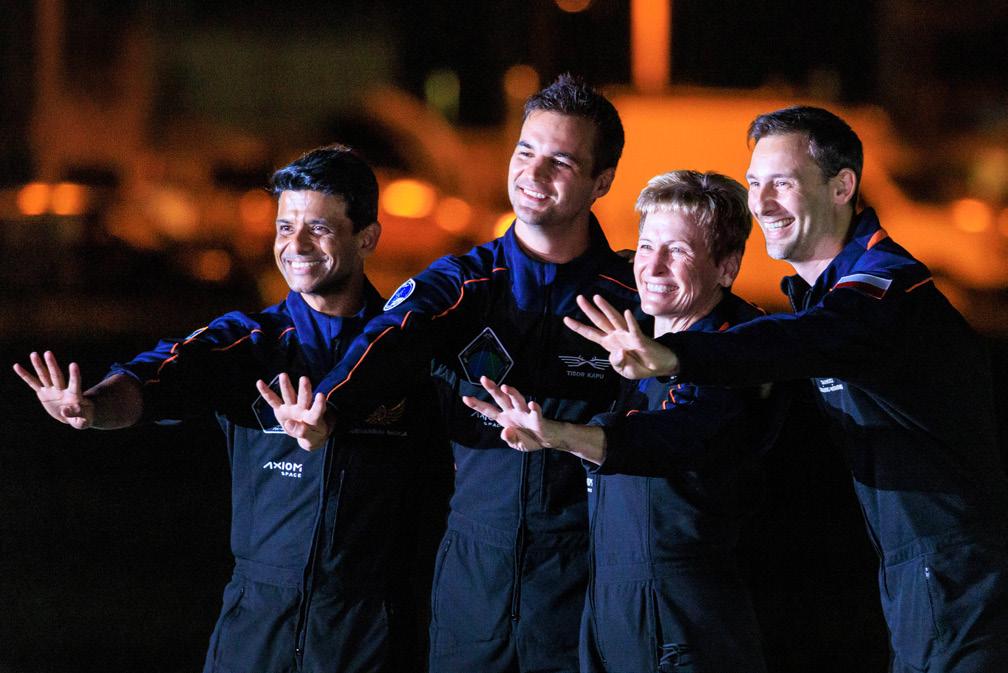
“Dear Poles, today we are taking a huge step towards the technological future of Poland, a Poland based on science and civilian knowledge. May this mission be the beginning of an era in which our courage and determination shape a modern Poland, for us and for future generations,” said Uznański-Wiśniewski. „Space has always united people. Today, I am taking a piece of each of you, your strength, your hope, and your trust with me from Earth,“ he added. ”I am not alone in space. I represent all of us. I thank you with all my heart for your trust. Space for everyone,” he concluded.
In addition to Uznański-Wiśniewski, the Axiom-4 mission crew on the ISS includes former NASA astronaut Peggy Whitson from the US, who is leading the mission, Shubhanshu Shukla from India (pilot) and Tibor Kapu from Hungary (specialist). Ax-4 is the fourth private crewed space mission organized by Axiom Space.
“I am representing all of you. We are flying to the International Space Station to conduct our technological experiments, showcase our technology, and at the same time prepare the technological future of Poland, not only for ourselves, but for the entire space sector, for a new generation of engineers who will be entering the market,” ,” said Uznański-Wiśniewski.
Uznański-Wiśniewski presented the mission’s mascot (“gravity indicator”), a plush swan named Joy. “It’s a wonderful feeling to be in orbit for the first time. When I first unbuckled my seatbelt, I didn’t feel entirely comfortable, but then everything calmed down, and when I looked out the window for the first time, the view was simply breathtaking,” he reported.
“The mission is a huge symbol of Poland’s advancement, of how Poland has moved forward technologically, and today we can demonstrate this directly in orbit,” he said.
The next day, the capsule has arrived at the International Space Station. Four astronauts have boarded the ISS.
According to plans, the flight to the International Space Station was to last approximately 29 hours. The docking procedure began before noon, when the capsule named Grace approached the ISS at a distance of 400 meters. Grace reached rendezvous point 2, meaning it was 20 meters away from the space station. The crew received permission to dock. Over the next three minutes, the distance between the two spacecraft decreased to ten meters. Docking began over the Atlantic Ocean. The adapters of the capsule and the ISS touched at 12:31 p.m. (this was a so-called soft capture).
“Welcome to the International Space Station,” the astronauts heard from Dragon before the hatch was opened. Permission to open the Grace capsule hatch was given at 2:13 p.m. Shortly thereafter, the hatch was opened. At 2:23 p.m., the four-member Grace crew was welcomed aboard the ISS.
There will be 11 people on the International Space Station for the foreseeable future - the Dragon crew will join the four astronauts in the American section and the three in the Russian section.
The members of the Ax-4 mission are scheduled to spend two weeks on the ISS. While in orbit, the astronauts will conduct numerous scientific and technological experiments. Among other things, the impact of microgravity on human health will be tested, including support for type 1 diabetics during short-term space missions and the study of the effects of microgravity on the brain and cognitive func-
tions of astronauts. The mission members will also study the growth and behavior of cancer cells in space, particularly in the context of breast cancer. The Polish astronaut will conduct 13 studies.
Uznański-Wiśniewski is a Polish engineer and scientist, a graduate of the Łódź University of Technology and the University of Nantes. In 2011, he obtained his doctorate at the Université d’Aix-Marseille, specializing in systems resistant to cosmic radiation. From 2018 to 2020, he supervised the work of the Large Hadron Collider at CERN. In November 2022, he became a reserve astronaut for the European Space Agency. He was selected for the Ax-4 mission in 2024 as a specialist.
Uznański-Wiśniewski said that he would have the opportunity to teach lessons to students. He expressed his hope that some of them would choose a career path like his.
Privately, Uznański-Wiśniewski is married to Aleksandra Uznańska-Wiśniewska, an MP of the ruling Civic Coalition (KO).
The first Pole in space was Mirosław Hermaszewski. On June 27, 1978, he set off on board the Soyuz 30 spacecraft on a mission that lasted over seven days. His flight was part of the international Interkosmos program, aimed at joint space research by the Eastern Bloc countries.
The agreement on the Interkosmos program, under which Hermaszewski’s flight took place, was signed in Moscow in 1976. The USSR, Poland, East Germany, Czechoslovakia, Bulgaria, Hungary, Romania, Cuba, and Mongolia participated in the project. Poland was to be one of the first countries to send its representative into Earth orbit.
Hermaszewski was among 400 candidates. After a series of demanding tests, he was selected for the flight alongside Soviet cosmonaut and Soyuz 30 mission commander Piotr Klimuk. Nine scientific experiments were carried out during the mission, five of which were the result of work by Polish scientists.
HERMASZEWSKI WAS AMONG 400 CANDIDATES. AFTER A SERIES OF DEMANDING TESTS, HE WAS SELECTED FOR THE FLIGHT ALONGSIDE SOVIET COSMONAUT AND SOYUZ 30 MISSION COMMANDER PIOTR KLIMUK
The mission ended on July 5, 1978, when the Soyuz 30 crew landed in Kazakhstan. The flight lasted exactly 7 days, 22 hours, 2 minutes, and 59 seconds.
Hermaszewski died on December 12, 2022, at the age of 81. Poland is participating in the manned flight carried out by the American company Axiom Space thanks to an agreement signed by the Ministry of Development and Technology and the European Space Agency for the preparation and implementation of the Polish technological and scientific mission IGNIS on the ISS. The Polish Space Agency (POLSA), an executive agency of the ministry, also participated in the preparations. The cost of the IGNIS mission is EUR 65 million. Finance Minister Andrzej Domański declared that the sum would be recouped many times over.

The victory of Karol Nawrocki, candidate of the former ruling Law and Justice (PiS), marks the beginning of another difficult period of cohab itation between the government and the head of state, following the presidency of Andrzej Duda. If the ruling October 15 Coalition, which is also plagued by internal friction, is unable to govern effectively, early parliamentary elections cannot be ruled out.
Nawrocki won with 50.89% of the vote in the second round. The candidate of the ruling Civic Coalition (KO), Rafał Trzaskowski, received 49.11% of the vote. The turnout was 71.63% and was the highest in the history of presidential elections in Poland.
The current head of Institute of National Remembrance (IPN) had the second-best result for a presidential candidate in the elections held in Poland since 1989, after Lech Wałęsa, who received over 74% of the vote in the second round of 1990 elections. The result achieved by Trzaskowski was the fourth-best result ever achieved by a presidential candidate. The difference between Nawrocki and Trzaskowski in the second round - 369,451 votes - was the smallest difference between presidential candidates who entered the second round in the history of elections.
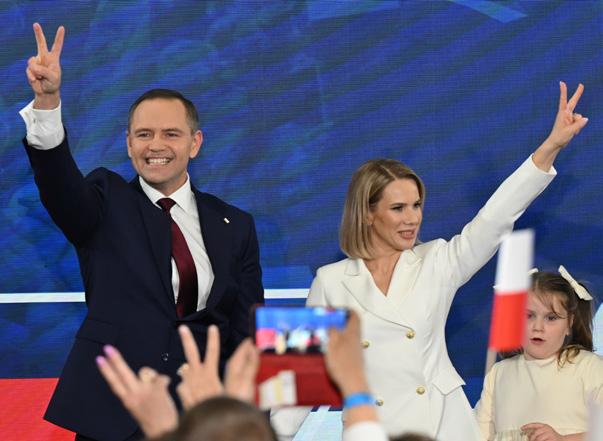
In the second round, Nawrocki was supported by the vast majority of voters who had voted for Sławomir Mentzen from radical-nationalist Confederation and Grzegorz Braun from Confederation of the Polish Crown in the first round.
Trzaskowski could count on the majority of votes from Magdalena Biejat of the New Left, Szymon Hołownia of Poland 2050 and Adrian Zandberg of the radical leftist Razem (Together) from the first round.
“The presidential election shows us all that Poles want to take responsibility for their future,” said President-elect Nawrocki, who received the State Electoral Commission’s resolution on his election as President of Poland at the Royal Castle in Warsaw. During the ceremony, Nawrocki thanked voters for going to the polls in the second round of the election and “fulfilling their duty to Poland and being ready to co-create our democracy.” He emphasized that he thanks them “regardless of how they voted in the first and second rounds” of the election. He added that the presidential election and the high turnout during the repeat vote “shows and proves to all of us that Poles want to take responsibility for their future”.
The 42-years-old president-elect assured that he would work not only for his voters, but also for those who voted for his opponents, assuring that he would be “the president of one Poland.” Among his priorities, he listed “breaking down the walls of hatred between Poles” and renewing public debate.
“Hatred cannot be an alternative to incompetent governments, hatred cannot be an alternative to political debate in the Polish parliament and in the lives of many social groups,” he said. “I believe that my presidency will also mark a new beginning in Polish politics, without walls of hatred, but with a deep sense that, thanks to this choice, the citizens of Poland are regaining their voice,” he added.
However, the second round of elections was not without controversy, which gave Nawrocki’s opponents the opportunity to speculate about fraud at the polls. Although both Prime Minister Donald Tusk and Sejm Speaker Szymon
Hołownia emphasize that the results - even if irregularities are found in some electoral commissions - clearly indicate Nawrocki as the new president, this does not prevent political turmoil.
The Supreme Court, which is considering protests against the election of the President of the Republic of Poland, has ordered an inspection of the ballot papers, which in practice means a recount of the votes in several dozen polling stations across the country. Authorized by Prosecutor General Adam Bodnar, a prosecutor from the Department of Judicial Proceedings of the National Prosecutor’s Office reviewed the protocols of the inspection of ballot papers from 10 district electoral commissions in the Supreme Court. According to information from the prosecutor’s office, in seven of them, votes were switched, which resulted in the erroneous assumption that Nawrocki had received a higher number of votes in those districts.
So far, about 12,000 protests against the presidential election have been registered with the Supreme Court; according to estimates, nearly 50,000 protests have been filed. After reviewing all of them, based on the election report presented by the State Electoral Commission (PKW), the Supreme Court, sitting in full session of the Extraordinary Control and Public Affairs Chamber, shall decide on the validity of the election. The decision shall be taken in open session within 30 days of the announcement of the election results. This means that the deadline for the decision is July 2.
Law and Justice chairman Jarosław Kaczyński believes that there are no grounds for recounting all the votes cast in the presidential election. According to him, those who
question the results are doing so because they are unable to accept defeat.
“There is no such institution as a recount of all votes, and there is a principle of legality; the state acts on the basis of and within the framework of the law,” he told reporters in parliament. “It is not in Poland’s interest what this gang is doing, trying to convince people that the elections were rigged,” he added. “We know that this is a terrible defeat for this coalition, the road to its downfall, and then to the reckoning for everything that has been going on here,” continued the leader of the former ruling United Right.
Immediately after the second round of voting, the Prime Minister announced that he would ask parliament to grant
AFTER A HEATED DEBATE AND MORE THAN 260 QUESTIONS POSED TO THE HEAD OF GOVERNMENT BY MPS, 243 VOTED IN FAVOR OF GRANTING THE GOVERNMENT A VOTE OF CONFIDENCE, WITH 210 AGAINST

a vote of confidence in the government. This took place on June 11. Before the vote, the PM delivered a policy speech in which he presented a list of his cabinet’s achievements and announced further measures planned until the end of the parliamentary term, i.e. until autumn 2027. During Tusk’s speech, there were almost no opposition Law and Justice MPs in the chamber.
After a heated debate and more than 260 questions posed to the head of government by MPs, 243 voted in favor of granting the government a vote of confidence, with 210 against. No one abstained. According to the law, a simple parliamentary majority was required to obtain a vote of confidence, with at least half of the total number of MPs present.
182 of the 189 MPs from the former ruling Law and Justice (PiS) voted against. Seven MPs, including Kaczyński, were absent during the vote.
All sixteen MPs from the Confederation, four from the Free Republicans and three from the Confederation of the Polish Crown also voted against.
The opposition was also supported by five MPs from the Razem.
The vote of confidence in Tusk’s government was unanimously supported by all members of the coalition parties - 157 members of the KO, 32 members of Poland 2050, 32 members of the Polish People’s Party (PSL) and 21 members of the Left.
“I needed this vote for obvious reasons,” Donald Tusk said after the vote. He mentioned speculation about the fall of his cabinet, saying that “it is difficult to work in such conditions.”
However, winning a vote of confidence in parliament did not put an end to speculation that the ruling coalition (which,
according to Tusk himself, is on the verge of a cabinet reshuffle announced for July) is losing its ability to act effectively in a situation where, according to many, the new president will consistently veto bills proposed by the government.
Former Education Minister, now PiS MP Przemysław Czarnek argued that Tusk’s vote of confidence was “the end of this government, only slightly postponed.”
“We knew that this vote of confidence would be granted, that the time between the idea and June 11, when this situation was scheduled, would also serve this purpose. These days were used to push the coalition partners against the wall, grab them by the throat and say: you still have to give me a vote of confidence,” he said.
Czarnek, who is likely to become head of the President’s Office, argued that similar situations “always ended very close” to the fall of the government. In this context, he cited the example of Leszek Miller’s left-wing cabinet and the vote of confidence in 2003. The politician agreed with the assessment that a vote of confidence is a sign that the government will fall. He also expressed the view that the fact that Tusk decided to make this move is evidence of his “unprecedented weakness.” “Everyone can see that this government is falling. When will this happen? I am not in a position to predict this, but I am convinced that it will be before 2027,” Czarnek declared, adding that “it cannot be ruled out that Tusk’s government will fall this year, in the fall.” When asked about the reasons for his conviction, Czarnek pointed to talks between PiS politicians and representatives of the ruling coalition, “who can clearly see the direction this government is heading in.” “And they know very well that when they return home, they have conversations with their families asking,


‘Why are you still serving this evil cause?’” he continued, adding that he did not want to name names.
According to business representatives, although the ruling coalition cannot expect full support for its policies from the new president, it has considerable room for maneuver in areas that can improve the competitiveness of the economy without causing political disputes.
Their statements suggest that deregulation is one of the areas that can and should unite politicians across party lines.
According to a pre-election appeal by the Entrepreneurship Council, Polish entrepreneurs need a president who is capable of constructive cooperation with the government, but at the same time one who can motivate and demand faster and more effective work from the authorities.
“We expect the new president to rise above party interests and work responsibly with the government on issues crucial to the future of our economy,” wrote Maciej Wituc-
ki, president of the Lewiatan Confederation of Employers, in a statement after Nawrocki’s victory was announced. He emphasized the need for the new president to revise his position on the European Union and Ukraine and to make a clear declaration of support for Poland’s membership in the EU.
The Employers of Poland do not want to officially comment on the election results, but according to Kamil Sobolewski, the organization’s chief economist, even with an opposition president, important changes can be made to accelerate the development of the Polish economy and businesses. Even if, in the current balance of power, there is no chance for comprehensive systemic reforms (such as raising the retirement age), which may meet with public resistance, there are many opportunities to pass pro-development laws that will increase the competitiveness and strength of the Polish economy without stirring up political disputes. Among these reforms, Sobolewski pointed to pro-development changes in the public procurement system and in taxes, including the bank tax (which would reduce margins and the cost of credit) and Belka’s [capital gains] tax, where the amount could be made dependent on the duration of the investment.
Jacek Goliszewski, president of the Business Center Club, also expressed his hope that the president and the government would engage in constructive cooperation on issues important to the economy and entrepreneurs, appealing to the new president not to block deregulation bills that are in the interest of not only entrepreneurs but also an efficiently functioning state administration.
For the first time since joining the EU, the European Commission has classified Poland as a country with high fiscal risk over the next decade.
Public debt rose to 57.4% of GDP after the first quarter. This amounts to PLN 2.1 trillion, an increase of over PLN 111 billion in three months and over PLN 351 billion in a year.
The Ministry of Finance has released information on public finance debt after the first quarter. The debt is shown according to two definitions: national and EU. The difference between them is over PLN 410 billion. The figure calculated in the same way as other European countries is higher. It is defined as the debt of the government and local government sector (EDP). After March, it already stands at 57.4% of GDP, or over PLN 2.12 trillion. It increased from 55.3% of GDP compared to the previous quarter, which means a quarterly debt growth rate of 5.5%.
A year ago, after the first quarter of 2024, EDP debt amounted to PLN 1.77 trillion.
“Stronger increases were observed at the beginning of the 21st century, during the financial crisis (2008-09) and the COVID-19 pandemic (2020),” wrote economists at PKO BP bank.
When looking for the reasons for such a significant increase in total debt, one can point to arms contracts, the loan portion of the EU National Reconstruction Plan (KPO), treated as public debt, as well as securing funds for future expenditures. This may also suggest that fiscal consolidation (reducing the deficit in relation to GDP) has not yet begun and the deficit continues to grow. Analysts have pointed out that the debt may exceed 60% of GDP before the end of this year.


THE AGENCY NOTED THAT POLAND WILL MOVE AWAY FROM THE PROJECTED MEDIAN PUBLIC DEBT FOR COUNTRIES IN THE “A” RATING CATEGORY - 57.2% VS. THE PROJECTED 61.6% FOR POLAND IN 2026
Debt in non-budgetary funds fell, mainly due to the repayment of PLN 18.5 billion in bonds issued by the Polish Development Fund (PFR) from the central budget. This does not mean that it has not increased in individual funds. The highest increases were recorded in the Aid Fund (PLN 4.8 billion), the COVID-19 Counteraction Fund (PLN 4.7 billion) and the Armed Forces Support Fund (PLN 4.1 billion). The debt of the National Road Fund increased by PLN 3 billion.
The share of debt to foreign investors fell by 0.4 pp to 35.0%. The share of the domestic banking sector in EDP debt was 43.8% (an increase of 0.4 pp compared to the previous quarter). 21.2% is part of the debt incurred outside the domestic banking system.
Rating agencies believe that the outcome of the presidential election threatens to slow down fiscal consolidation.
“The outcome of the presidential election in Poland is likely to continue to pose challenges to economic reforms and sustainable fiscal consolidation and may exacerbate institutional conflicts,” Fitch Ratings said. It pointed out that Karol Nawrocki’s presidency is likely to continue to hamper the implementation of the ruling coalition’s policies.
Poland’s general government deficit rose to 6.6% of GDP in 2024 from 5.3% in 2023, exceeding both the Ministry of Finance’s estimate (5.7%) and Fitch’s forecast (6.2%). This has pushed up the ministry’s plans for 2025. It plans only a slight reduction in the deficit, to 6.3% of GDP, although in the “Medium-Term Budgetary and Structural Plan for 2025-2028” it assumed a deficit of 5.5%. According to this document, the deficit was supposed to fall below the 3% threshold in 2028. Taking into account the data for 2024 and forecasts for 2025 (and 2026: the European Commission expects a result of as much as 6.1% of GDP), this would require even more significant fiscal consolidation than planned by the Ministry of Finance. A year ago, the ministry planned to reduce the deficit to 4.5% of GDP in 2026.
The president’s prerogatives in the context of fiscal policy are limited to legislative initiatives, but Nawrocki promised, among other things exempting families with at least two children from personal income tax (up to PLN 140,000 per year for each parent), raising the second tax threshold from PLN 120,000 to PLN 140,000 PLN, abolishing the [capital gains] Belka tax up to PLN 140,000 of annual income, and extending tax relief to self-employed persons paying a flat tax and lump-sum tax. He also announced that he would submit a bill to reduce the VAT rate from 23% to 22%. He also gave his word that he would not sign any bill raising taxes.
Although the government did not announce any socially difficult reforms as part of its exit from the excessive deficit procedure - rather, it announced increases in excise duties on alcohol and cigarettes and tightening of the corporate tax collection system - it did, among other things, freeze the parameters of the PIT tax scale. This did not prevent it from continuing to promise to raise the tax-free allowance from PLN 30,000 to PLN 60,000.
Fitch has been talking about a significant deterioration in Poland’s fiscal situation for months. This is no longer a gradual increase in debt. The failure of fiscal consolidation plans is cited as the main risk factor for our rating and its outlook. The agency noted that Poland will move away from the projected median public debt for countries in the “A” rating category - 57.2% vs. the projected 61.6% for Poland in 2026.
“Weakened confidence in the government’s ability to carry out fiscal consolidation in line with stabilizing debt at a level similar to that of countries with similar ratings in the medium term is a risk factor for Poland’s A- rating with a stable outlook,” Fitch warned.
TAXES
TRANSFERS, THE RICHEST 1% OF POLES “COLLECT” ABOUT 10-11% OF THE TOTAL NATIONAL INCOME
The post-election situation in Poland was commented on in a similar vein by other major rating agencies. Moody’s assessed that consolidation may be delayed because Donald Tusk’s government will not pursue unpopular cuts. S&P Global wrote about “growing fiscal risk” and assessed that the prolonged political deadlock suggests that the likelihood of fiscal reforms is low. At the same time, the agencies note the numerous advantages of the Polish economy, such as solid economic growth, diversification of the economy, a flexible labor and product market, and a well-educated workforce.
Fiscal consolidation may be all the more difficult as both sides of the political conflict want to reduce, not increase, the tax burden.
Karol Nawrocki’s tax proposals were calculated even before the elections by economists from the Center for Economic Analysis (CenEA). They concern three promises: raising the second tax threshold to PLN 140,000, a 0% PIT for families with at least two children, and extending family allowances to various taxation rules. “Nawrocki’s tax program is clearly aimed at the wealthiest,” the analysts concluded. The full set of reforms analyzed would mean an annual loss of over PLN 19 billion for the budget, of which PLN 9 billion would remain in the pockets of the top 10% of earners.
Analyzing the effect on households with children alone, it is clear that those with the highest incomes would benefit the most. Families in the highest decile (i.e., the 10% with the highest incomes) would gain an average of PLN 1,080 per month, while families in the lowest group would gain a mere PLN 6.
Poland already ranks among countries with relatively high levels of inequality. After taxes and transfers, the rich-

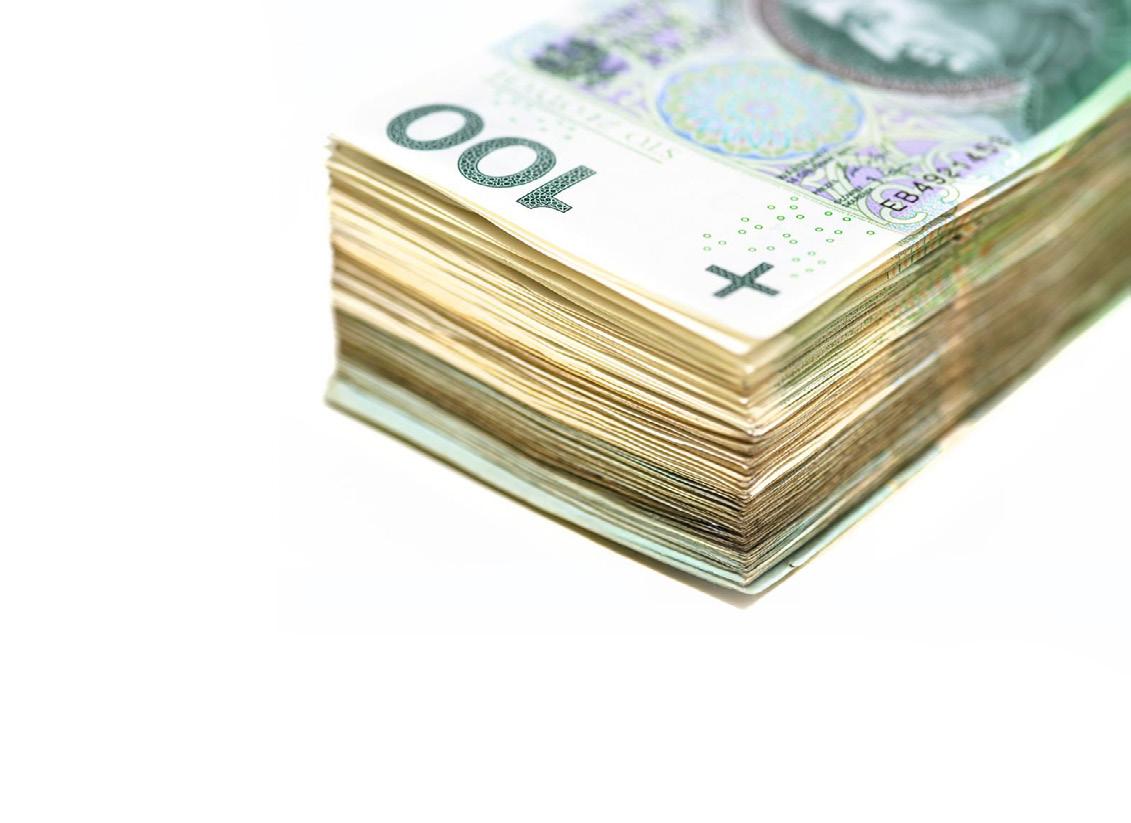
est 1% of Poles “collect” about 10-11% of the total national income. This group is characterized by a fairly low propensity to consume, so it does not particularly stimulate the local economy. In addition, it invests heavily in real estate, driving up prices.
At the same time, it is worth noting that the ruling Civic Coalition’s flagship promise - to raise the tax-free allowance from 30% to 60% – would bring greater financial benefits to those who earn more.
Poland is on a dangerous fiscal path, warn economists Sławomir Dudek, Piotr Kalisz, and Ludwik Kotecki in their latest report, “The Threat of Excessive Public Debt.” The year 2024 ended with a general government deficit of 6.6% of GDP in Poland, the second highest in the European Union after Romania.
This was also significantly higher than the Ministry of Finance’s plans (5.7%). The situation is worsening despite solid economic growth: 2.9% in 2024.
What is more, the ministry’s assumptions for 2025 foresee only a slight reduction in debt, to 6.3%, which is well above the EU threshold of 3% of GDP, which Poland was supposed to achieve by 2028, in line with its commitments under the EU’s excessive deficit procedure.
Poland has the second highest deficit in the entire European Union, the second highest debt servicing costs in the EU, and very high debt growth.
Public sector spending reached 49.4% of GDP in 2024, the highest in history and more than the EU average. Poland has overtaken countries such as Spain, the Netherlands and Denmark in this respect, and spending is already comparable to that of Germany and Sweden.
Budget revenues amounted to 42.8% of GDP in 2024. This is significantly less than the EU average (46%) and, at the same time, too little to finance record spending.
Poland’s public debt is growing rapidly, from 49.5% of GDP in 2023 to 55.3% in 2024, and the Ministry of Finance forecasts an increase to around 58% this year. The authors of the report also refer to European Commission forecasts, which assume that by 2035 it could reach as much as 95% of GDP. Although the assumptions of this scenario are pessimistic (including low real economic growth of around 2%, maintaining the primary structural deficit at around 3% of GDP, stabilizing the cost of debt at 4% of GDP per year), they can be treated as a certain direction in the absence of sufficient consolidation efforts or the effect of negative GDP, stabilization of debt costs at 4% of GDP per year), they can nevertheless be treated as a certain direction in the absence of sufficient consolidation efforts or the effect of negative economic shocks. For the first time since joining the EU, the European Commission has classified Poland as a country with high fiscal risk over the next decade.
One of the important, but not the only, reasons for the growing deficit is high defense spending. EU regulations
POLAND’S PUBLIC DEBT IS GROWING RAPIDLY, FROM 49.5% OF GDP IN 2023 TO 55.3% IN 2024, AND THE MINISTRY OF
offer member states a kind of lifeline: it is possible to deviate from the consolidation path by up to 1.5% of GDP (exit clause) in connection with this spending. However, this is only a temporary solution, providing short-term flexibility.
The authors of the report present several recommendations for the government, including presenting a credible and detailed path for future fiscal consolidation and reducing the budget’s borrowing needs.
In addition, there is a proposal to put Poland’s public finances in order by phasing out the functioning of extra-budgetary funds in the state-owned bank BGK and adopting, with a certain transition period, the EU definition of public debt in national fiscal rules. Today, funds in BGK are not included in the national definition of public debt enshrined in the constitution, but are taken into account in EU criteria. For this reason, public debt according to national rules amounted to around 45% of GDP at the end of 2024, while according to EU rules it was more than 10 percentage points higher.
On June 3–4, Warsaw hosted the 61st annual conference of AESGP – Association of the European Self-Care Industry. The event, organised in partnership with PASMI, the Polish Association of Self-Medication Industry, was held under the slogan “Prevention through Self-Care” and gathered over 300 representatives of the healthcare sector from all over Europe.
This year’s conference was held at a breakthrough moment, during the Polish Presidency of the EU Council and work on the largest reform of EU pharmaceutical law in years.
The main topic of the meeting was the role of overthe-counter (OTC) drugs and self-medication in modern healthcare systems in the face of an aging society and rising healthcare costs.
This year’s conference brought together leaders, decision-makers and stakeholders to reflect on the future of self-care in Europe and how supporting individuals in prevention can shape a new healthcare paradigm that combines well-being with sustainability. It was a unique opportunity to exchange experiences and work together to strengthen the role of OTC drugs in modern healthcare systems,” said Jurate Svarcaite, Director General of AESGP.
Speaking at the conference, Adam Jarubas, Member of the European Parliament and Chairman of the Public Health Committee (SANT), highlighted specific data confirming the importance of self-medication for healthcare systems and the economy.
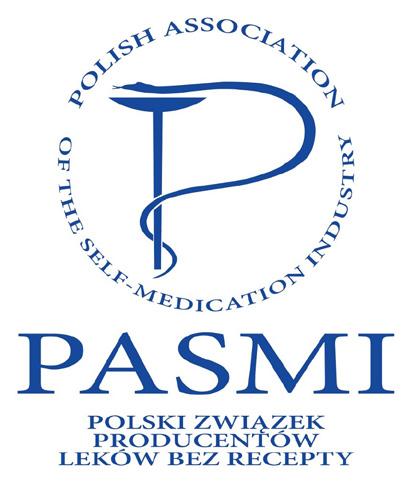
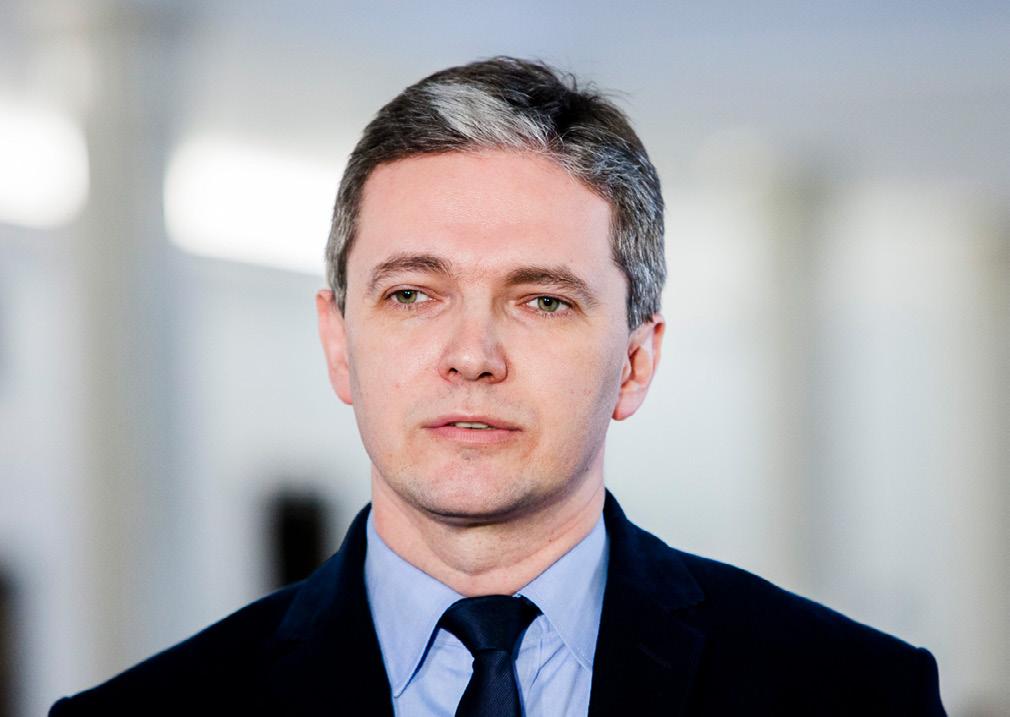
He said that over 1.2 billion minor ailments are self-managed in Europe each year through the use of non-prescription medicines, saving significant healthcare costs and freeing up doctor’s time. This practice of self-care is estimated to save around 40 billion euros annually in Europe.
“Every euro invested in self-medication can bring up to EUR 6.90 in economic benefits. This is a clear signal that prevention and citizens’ health independence must become the cornerstone of our health policy,” Jarubas said.
The conference participants also discussed how self-medication affects the work of doctors. It was pointed out that if every patient with a minor ailment consulted a primary care physician, it would be necessary to employ an additional 120,000 of them across the EU. In light of this data, there is the need to develop patients’ health competences and health education so that they can safely and effectively cope with common ailments themselves.
Digital innovations in healthcare were also an important part of the debates. According to experts, artificial intelligence (AI) can bring significant benefits in self-care, enabling a more personalised approach to prevention and early detection of health problems. The conference included a session devoted to the practical applications of AI in the self-care sector.
There were also panels devoted to regulations concerning dietary supplements and medical devices. During one of the sessions, the results of a new study on the value of vitamins and minerals in supplements were presented, taking into account the current legal framework and proposals for maxi-
mum levels of these ingredients in the EU. The debates also touched on regulatory issues concerning medical products used in self-medication.
The conference was attended by representatives of European institutions, including the European Commission and the European Parliament, as well as national health institutions and leaders of the pharmaceutical industry.
“The AESGP conference came at a crucial time as we experience major demographic changes, face deregulation issues and disruptive technological innovations. As the European Union prepares to implement one of the most profound pharmaceutical law reforms in its history, we must ensure that OTC medicines and the principle of selfcare find their place in it,” said Ewa Jankowska, President of PASMI.
“Let us remember that self-medication is not a fad, but a necessity for ageing societies and overburdened healthcare systems,” she added.
PASMI is a member of AESGP and actively cooperates with European organisations whose goals and activities are consistent with its statutory activities. Currently, the association brings together 18 entities: Aboca Polska, Adamed Pharma, Bayer, Haleon Poland, Kenvue, Klosterfrau Healthcare, MagnaPharm Poland, Mayoly Polska, Opella Healthcare Poland, Perrigo Poland, Tarchomińskie Zakłady Farmaceutyczne Polfa, Zakłady Farmaceutyczne Polpharma, Polski Lek – Dystrybucja, Procter & Gamble Polska, Reckitt Benckiser Poland, Teva Pharmaceuticals Polska, USP Zdrowie and Verco.
An overwhelming majority of Poles believe in life-lasting relationship with the average length of a relationship in Poland being 19 years, according to a study commissioned by the pharmaceutical company Gedeon Richter Polska.
The latest report “Anatomy of a relationship. Face to face about relationships” sheds light on the complex picture of how Poles function in relationships, showing both their strengths and weaknesses.
As many as 83% of adult Poles being in a relationship believe it can last a lifetime. The primary driver behind Poles forming couples is love (60%). For 89%, their relationship is also the first and only one.
Respondents also claim they feel safe in relationships (80%), receive support and love from their partners (close to 75%).
This romantic myth is deeply rooted in Polish culture, says Robert Kowalczyk, clinical sexologist and psychotherapist, but adds that from his professional experience the reality may be a bit different.
“On the one hand, we are convinced that a relationship provides stability and that we enter into it out of love, on the other hand, this romantic myth often conceals violence, unhappiness, staying together at all costs, for example, for
the children’s sake,” he says. His observations also indicate it is mainly women, “guardians of the home”, who take care of relationships while for a man, it is enough to just be in a relationship.
More than two-thirds of the couples surveyed (68%) declare monogamy. Every fifth person has spent more than three decades with one partner, and half of the couples who have been together for 20-29 never had another relationship before. Among those, as many as 97% are married, and they rate their level of life satisfaction is at an average 7.9 out of 10.
For the vast majority of Poles (81%), the ability to communicate effectively is a vital component of a healthy and fulfilling relationship. Although 80% believe they can share their thoughts, feelings and needs with their partner and 76% declare the ability to address disagreements and con-


flicts in a constructive manner, almost half of couples experience “quiet days,” and 40% prefer to avoid difficult topics.
At the same time, the study shows that in almost every tenth relationship there have never been even minor arguments, and in almost half of them, arguments occur no more than once a month. Every fourth person admits to frequent arguments, at least once a week.
Poles argue mainly about trifles (55%), finances (25%) and division of responsibilities (24%). According to Marta Niedźwiecka, a psychologist and sex coach, an angry reaction is not always linked to the subject matter of the argument but may disclose a deep level of misunderstanding, an unfair share of responsibilities related to family and everyday household chores, or other contentious issues.
The optimistic thing is that couples therapy is gaining recognition among Poles. As many as 47% of respondents consider it an effective tool for helping their relationship, and more than half of the couples who went through a serious crisis say they came out of it stronger.
As regards the intimate sphere, Poles rate their sex life at 7.4 out of 10 citing “physical fatigue” as the main “obstacle” to sexual activity and desire (29%). Although Poles have five lifetime sexual partners on average, as many as 25% of respondents admit to only one. Infidelity, although a common phenomenon, is not limited to sex for most people. A virtual relationship or a kiss can also be considered cheating.
Among the most important factors guaranteeing a successful relationship, Poles mention respect, loyalty and
support. Although common passions or political views are important, 65% point to spending time together and 58% to agreement on life goals as key to building true closeness.
For the vast majority of Poles, a relationship also means health support. As many as 80% believe it is easier to take care of their fitness with a partner. They actively remind each other about preventive tests (72%) and are ready to take care of the other half in sickness (91%).
For most Poles, technology is both a blessing and a curse for a relationship. On the one hand, 72% of couples believe that instant messaging helps maintain closeness, especially in long-distance relationships. On the other hand, 65% feel that digital communication can make relationships shallower, and one in five couples argues about social media. Artificial intelligence is also a concern for 44% who fear that virtual partners may replace real relationships in the future.
The Beach Boys, a legendary American rock band formed in Hawthorne, California in 1961, will play its first ever gig in Poland on the Summer Stage of Warsaw’s Progresja Club on July 13.
They are one of the most critically acclaimed and commercially successful bands of all time, with over 100 million records sold worldwide. From the 1960s to the present, the group has had over 80 songs on the charts, 36 of which have reached the American Top 40 and four have reached number one on the Billboard Hot 100.
In 1988, the band was inducted into the Rock and Roll Hall of Fame and honoured with the Grammy Lifetime Achievement Award from The Recording Academy.
The Beach Boys are an undisputed icon of pop music, whose work has inspired many generations of musicians. Their influence on the development of pop and rock is hard to overestimate. Many artists, including Paul McCartney of The Beatles and Syd Barrett of Pink Floyd, have
said how important the Californians’ music was in the creation of their celebrated songs.
The Californian lifestyle, sun, surf, beaches and cars, was a key motif in their early work. Their music perfectly reflected the atmosphere of the West Coast of the USA and they quickly became a symbol of the “California Dream” .
The joyful, carefree style with rich vocal harmonies and characteristic guitar sound of the 60s still inspires many surf rock artists. Over the years, their work evolved. Influenced by The Beatles, Brian Wilson, one of the Beach Boys, decided in 1966 to record Pet Sounds, an album that pushed the boundaries of pop music. In the 70s the band returned to a more classic sound, and from the late 80s focused on touring.
The most recent studio album by the Beach Boys “That’s Why God Made the Radio” was released in 2012 to celebrate their 50th anniversary.
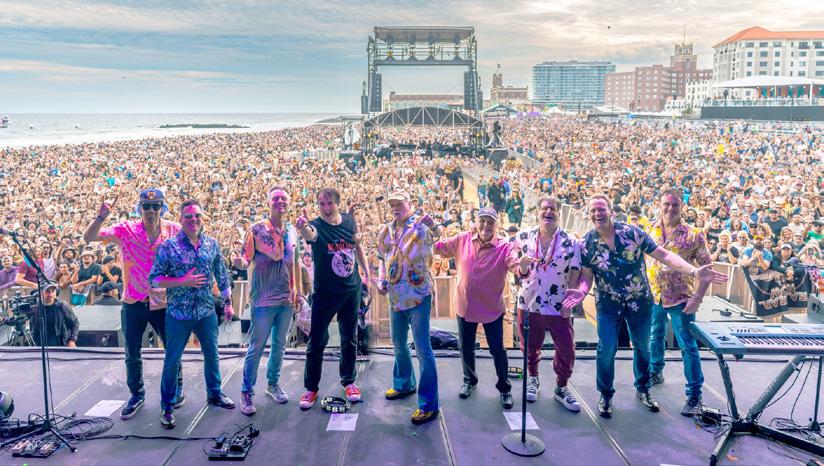

Co-founder of the legendary duo Eurythmics, Dave Stewart, will come to Warsaw on July 23, where he will play, accompanied by vocalist Vanessa Amorosi, on the Summer Stage of the Progresja Club. The audience will hear ”Sweet Dream”, “Here Comes the Rain Again” and other great hits of Eurythmics live.
Virtually every note played by Stewart turned out to be an international hit. For over forty years, the artist, in addition to the successes achieved with Annie Lennox under the Eurythmics
banner, produced albums and helped compose songs by artists such as Bob Dylan, Mick Jagger, Gwen Stefani, Stevie Nicks, Bryan Ferry, Katy Perry, Sinead O’Connor, Aretha Franklin, Al Green, Joss Stone and many others.
He has been honoured with numerous awards for his storied career, including four Brit Awards, a Golden Globe and Grammy. In 2022, he and Lennox were inducted into the Songwriters Hall of Fame, and then the Rock and Roll Hall of Fame.
Warsaw will become the capital of world hiphop for one day. On August 10. 50 Cent the legend of world rap, Grammy winner, author of hits such as In Da Club, Candy Shop and P.I.M.P. will perform at PGE Narodowy, the largest stadium in Poland.
The Warsaw concert will wrap up his ‘Legacy Tour’ marking the artist’s first return to the road since his successful ‘Final Lap Tour’ in 2023, which grossed over USD 103 million.
Organisers say that the biggest concert of this artist in Poland so far will be “a monumental, world-class show on a gigantic stage, with stunning visual effects.”
50 Cent said of the trek on Instagram: “The Legacy Tour is here. I’m hitting Europe this summer to celebrate the music, the moments, and my 50th birthday. You know it’s gonna be crazy!”
Curtis Jackson, known as 50 Cent, soared to fame with his 2003 debut album ‘Get Rich or Die Tryin,’ considered one of the most important albums in hip-hop history. He has sold over 30 million albums worldwide, and in addition to a Grammy Award, has won 13 Billboard Music Awards, six World Music Awards and three American Music Awards.
Outside of music, 50 Cent has enjoyed enormous success as an actor (Get Rich or Die Tryin’, Power, Den of Thieves) and as a film and television producer.
His concerts are a strong dose of energy, a significant part of rap history played live with New York ease and famous for their spectacular production and the atmosphere that takes the audience straight to the streets of South Jamaica Queens, where 50 Cent began his path to the top.

Jennifer Lynn Lopez, also known as J.Lo, one of the most influential entertainers of our time, returns to the Polish stage with a concert as part of her summer tour Up All Night Live In 2025.
She will perform at the PGE National Stadium in Warsaw on July 25. This will be the artist’s second appearance in Poland, after a concert in Gdańsk in 2012. The audience can expect an electrifying performance of her chart-topping hits from across her decades-spanning career.
Lopez began her career as a dancer, gaining early recognition as a “Fly Girl” on the sketch comedy show In Living Color.
She transitioned into acting, with a major break coming with the role of Selena in the biographical film Selena (1997). Simultaneously, she began her music career with her debut album, On the 6, in 1999”. After that, she released nine more albums and achieved huge success in the music market. To date she has sold over 80 million records, amassed over 15 billion streams and has nearly 28 million monthly listeners on Spotify alone.
Her biggest hits include “Let’s get loud”, “Jenny from the block”, “Waiting for tonight” and “On the floor”. From her iconic dance anthems to her soulful ballads, Lopez is sure to deliver a multimedia show full of dance and special effects like no other.

The new exhibition at the Xawery Dunikowski Sculpture Museum in Królikarnia is dedicated to Polish female sculptors from the early 20th century, who left Poland to study in the Parisian studio of the famous sculptor Antoine Bourdelle.
Entitled “Destination Paris.” the exhibition is the second instalment of the research project “Polish Women Sculptors of the 19th–20th Century,” run in collaboration with the Musée Rodin in Paris, Musée Camille Claudel in Nogentsur-Seine and Musée Antoine Bourdelle in Paris.
In the early 20th century, sculpture was not widely associated with femininity in mainstream art circles. The practice of sculpture, along with painting, was often perceived as a masculine pursuit due
to the materials and techniques involved. In Poland, this perception was also influenced by the historical exclusion of women from art academies and the limited opportunities they had for formal training in sculpture. This state of affairs made Polish female artists seek training abroad. Paris, the world’s art capital at the time became a natural choice.
Many Polish artists at the time would seek education in the studio of Antoine Bourdelle, a professor at the Académie de la Grande Chaumière, He was an important figure for Poles as an active supporter of Poland’s struggle for independence and the creator of the Monument to Adam Mickiewicz, one of Poland’s most important poets, in Paris. But, above all, he was an esteemed sculptor and educator who strove not to impose his own vision but to inspire. Among his
students were Jadwiga Bohdanowicz, Janina Broniewska, Luna Drexler, Helena Głogowska, Maria Szczytt-Lednicka, Kazimiera Pajzderska-Małaczyńska, Olga Niewska, Mika Mickun, Zofia Trzcińska-Kamińska. After completing their education under Bourdelle , they found their own artistic language. Their talent, determination and dedication to art brought successes, also on the international stage.
The exhibition, which showcases over 200 works of select Polish women artists, not only sculptures but also medals, paintings, fabrics and photographs, shows their connections with the art of the master, their search for their own path, individual style, diversity of forms, materials and themes. The display is supplemented with a selection of archival photographs and documents.


The Ujazdowski Castle Centre for Contemporary Art hosts the exhibition “Soil and Friends,” as part of an interdisciplinary artistic and research project that combines art and ecology.
The visitors to the exhibition will be able to find answers to a number of questions: What can we learn from plants? Can knowledge about soil deepen our understanding of humanity’s place in the world? Why do artists increasingly migrate from the field of art to the cultivation of land? How can art institutions consciously support ecological imagination?
The project “Soil and Friends” includes a group exhibition, an educational and performative programme, artist residencies, and site-specific activities. The narrative frame-
work of the project is built around the relationships between humans and the land—as territory, ground, and soil, the entangled stories of plants, humans, and non-human beings, various ways of coexisting with and experiencing the world, and the intersections of art with the practices of cultivating and caring for the land.
The location of the exhibition is not accidental. The surroundings of Ujazdowski Castle, its park and the Vistula escarpment, have for many years provided a space for research and action at the intersection of art and ecology. Soil and Friends builds on previous initiatives, continuing the reflection on art as a space for a shared experience of nature.
In 2026, the second instalment of the exhibition will take place at the Plato Gallery of Contemporary Art in the Czech city of Ostrava.
The participating artists include Milena Bonilla,Centrala, Julia Ciunowicz, Yoeri Guépin, Gosia Kępa, Kateřina Konvalinová & Judita Levitnerová, Krzysztof Maniak, Maksud Ali Mondal, Deirdre O’Mahony, Julia Ábalos Reznak, Anna Siekierska, Sounding Soil, Salka Tiziana, Ewelina Węgiel, Anka Wandzel, Jaśmina Wójcik and Lea Wróblewska, Zabriskie Buchladen für Kultur und Natur
Until October 26.
The legendary Hair: The American Tribal Love-Rock
Musical with the book and lyrics by Gerome Ragni and James Rado and music by Galt MacDermont returns to the Polish theatre stage after many years with the new production by Proscenium Musical Theatre.
The musical show at Scena Relax in Warsaw brings back the Age of Aquarius and the beautiful time of the Flower Children, once again recalling the important and timeless message of peace and love.
Hair was a musical form of a manifesto created in the United States in the 1960s by members of the hippie counterculture, who wanted to oppose social changes or the state’s involvement in the Vietnam War in an unconventional way. The show was enthusiastically received by the audience and named “cult and revolutionary”. It gained additional popularity thanks to its film adaptation directed by Miloš Forman. In 1980 it also reached Poland, where it was screened in the reality of the country behind the “iron curtain” at Warsaw’s Relax Cinema. Today, history has come full circle and the title can be seen again on the Relax musical stage.
Hair by the Proscenium Musical Theatre, directed by Antoniusz Dietzius, is a colourful, liberated and moving performance,
created with respect for the original. Audience will hear such immortal hits as ‘Aquarius’, ‘I Got Life’ and ’Let the Sunshine In’. The show’s greatest strength is a young cast who, from the first sounds of the cult music, share with the audience a sense of understanding, acceptance, smile and fight for their own ideals.
“The revival of Hair on the Polish stage is not accidental,” says Dietzius. “The reality in which we now live, the world with wars, political changes, the feeling of lack of acceptance and often everyday hostility are enough to reach for material manifesting a sense of love, understanding, mutual tolerance and pacifism,” he adds.
Santiago Bello, the choreographer says that working on the musical was “an incredibly revealing experience” for him, both on an artistic and personal level.
“It was a path of liberation, on which I broke many of the choreographic barriers I had known before, opening myself to a much more instinctive, lively and authentic way of creating. I was looking for an explosion of energy, a celebration of the body in all its glory, as if every gesture was an act of joy and affirmation,” he says.
The cast includes Mateusz Tomaszewski, Michał Talar, Angelika Izabela Kurowska, Marta Rodziejczak, Mateusz Otłowski and Dominika Sobol.
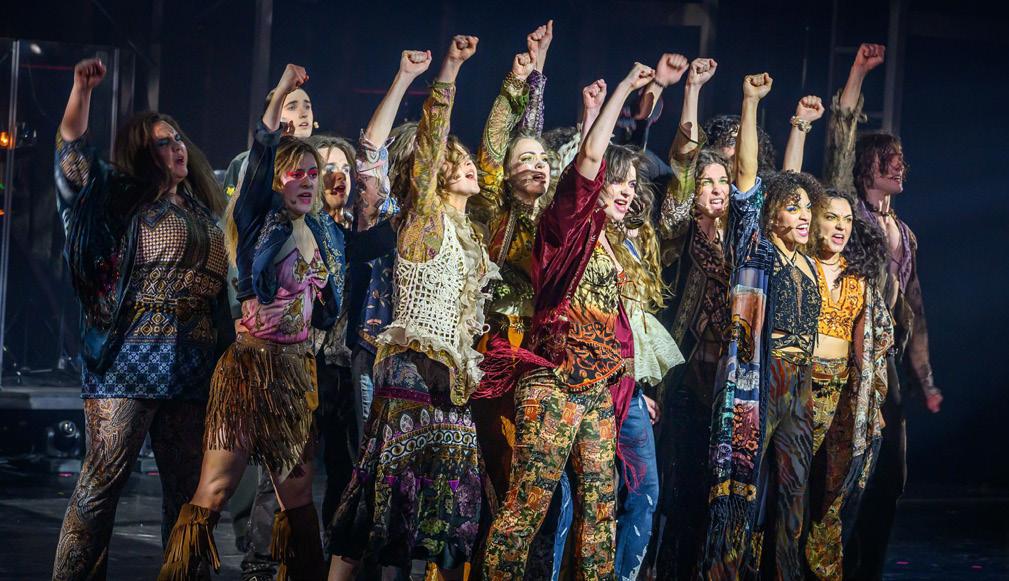
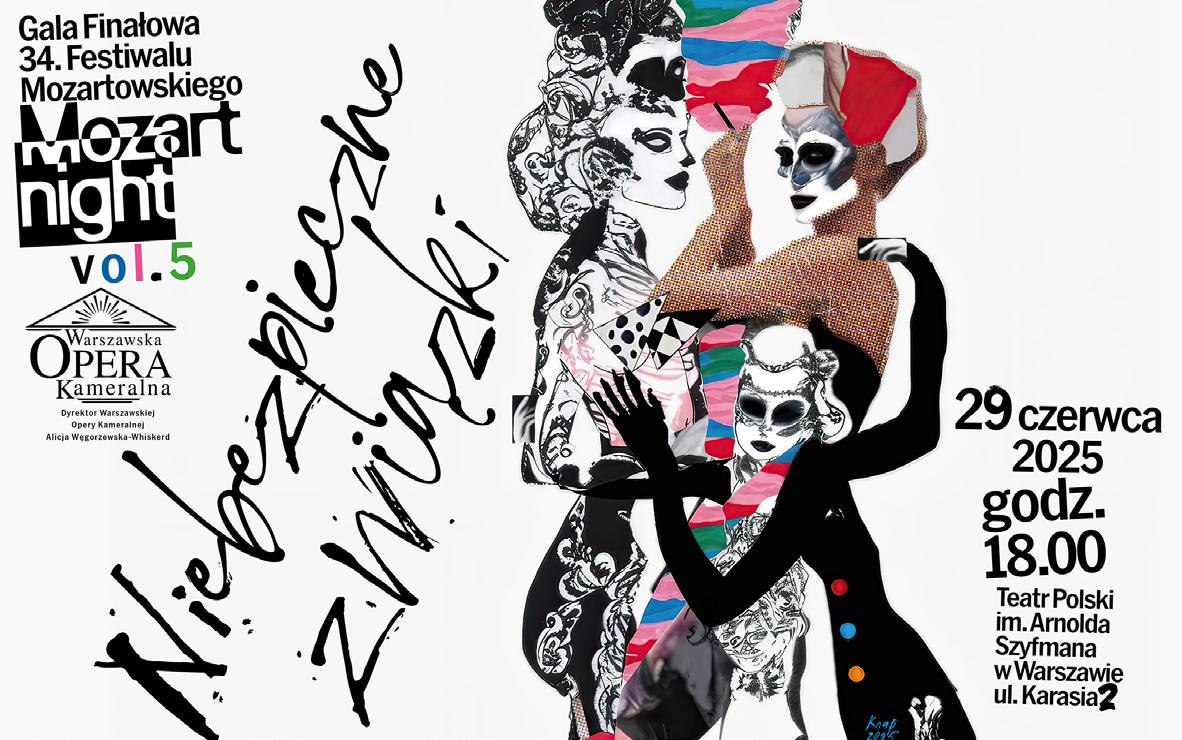
The Mozart Night Gala in Warsaw, the traditional concluding event of the annual Mozart Festival organised by the Warsaw Chamber Opera (WOK) will be held at the Polish Theatre on June 29. The grand finale event, directed by Tomasz Cyz, will feature the interpretation of Mozart’s Requiem by the conductor Howard Arman. The concert will bring many renowned artists to the stage,
including cellist Tomasz Strahl, violinist Agata Szymczewska and soloists Aleksandra Lowe (soprano), Aleksandra Olczyk (soprano), Yujie Zhou (soprano), Maya Gour (mezzo-soprano), Stefan Sbonnik (tenor) and Hubert Zapiór (baritone). They will be accompanied by the Vocal Ensemble of the Warsaw Chamber Opera conducted by Krzysztof Kusiel-Moroz and by the Early Instruments Orchestra of the Warsaw Chamber Opera, Musicae Antiquae Collegium Varsoviense (MACV), conducted by Adam Banaszak.
The Mozart Festival in Warsaw is the longest festival in the world devoted exclusively to the work of the brilliant composer from Salzburg. This year, it was organised by the WOK for the 34th time, featuring Mozart’s most famous operas, chamber concerts, oratorios and accompanying events, including those dedicated to the youngest music lovers.



One of Andy Warhol’s most outstanding works, The Alphabet Soup, will permanently reside in the lobby of the new premium investment Gutenberg Apartments in Warsaw’s Wola district.
”We have revolutionised the Warsaw market by introducing a collection of art to luxury apartments,” says Dawid Wrona, Chief Operating Officer at Archicom Collection, the developer of Gutenberg Apartments.
Warhol’s work is a revolutionary concept that has gained enormous fame in the art world, paving the way for the global domination of the pop art movement, blurring the boundaries between high and popular art. The Alphabet Soup is inspired by the motif of Campbell’s soup cans. With this iconic work Warhol showed that everyday objects and motifs can have an artistic dimension. Warhol continued to explore the motif, using a modified silkscreen technique to create an unlimited number of copies of the same image. It was thanks to him that reproduction became an art.
“Screen printing fits perfectly into the concept of the investment, which refers to the printing heritage in every detail,” says Wrona.
Gutenberg Apartments are a continuation of this idea, implemented on the former premises of the Dom Słowa Polskiego Graphic Works, once the largest printing plant in Poland.
“Art should not be confined to museums, it should be part of our everyday lives,’ says Joanna Kiliszek, curator of the Archicom Collection Gallery. “Presenting this work in the common space of the Gutenberg Apartments means that residents and guests can experience it in a completely new context, where history meets modernity,” she adds.
Maciej Rydz, architect from the renowned JEMS Architekci studio which designed the Gutenberg Apartments, says that they
wanted to create a space that would reflect the site’s history with the details directly referring to the heritage associated with printing and the written word.
The skeleton facade brings to mind the design of former printing factory halls. Another characteristic feature of the buildings will be the high windows, covering two floors in the common areas. It is also a nod to the abundantly glazed buildings of the former printing house.
“The project pays homage to the printing past of its location, while at the same time paying tribute to two great individuals of world culture – Johannes Gutenberg, [who invented the printing press] and Warhol,” he says.
The Gutenberg Apartments will be an integral part of the multifunctional Towarowa22 project, whose investors are AFI, Echo Investment and Archicom.
“The shape, divisions and rhythm of the nearby modernist architecture of Warsaw were a model, inspiration and starting point for our vision,” says Rydz.
The project comprises two tower buildings with a total of 160 flats of varying sizes. Their elegance and functionality are created with such noble materials as wood, stone, glass and copper. Residents of Gutenberg Apartments will have an access to a wide range of amenities, including own conference room, lounge, media and book library, cinema room, fitness and spa area with saunas and a swimming pool inspired by Roman baths.
The common areas will be decorated with a collection of works by renowned Polish contemporary artists, including Tymek Borowski, Magda Komar, Paweł Kowalewski and Mirosław Maszlanko as well as a unique collection of art referring to lettering, literature and the history of the place.
The 25th Musical Gardens Festival, taking place from June 29 to July 31, will feature over 30 musical events at the Great Courtyard of the Royal Castle in Warsaw. The festival, titled “Fireworks and Fanfares,” will showcase a variety of musical genres, including classical, traditional, and jazz music.
The event aims to create a magical atmosphere with music, lights, and emotions. Its programme includes live concerts with both Polish and international artists and rebroadcasts of performances from renowned theatres and music festivals, screenings of operas and ballets as well as filmed concerts.
The festival will be inaugurated by the concert “Royal Fanfares and Subtleties of Nature” co-organised by the Sinfonia Varsovia orchestra, which will perform under the baton of Michał Klauza and accompany an outstanding soloist, violinist Meruert Karmenova.
The program of the jubilee edition will also feature a performance by a famous Polish baritone Artur Ruciński, a star of the world’s greatest opera stages, including the Metropolitan Opera in New York, who will give a recital with Gabriela Legun, one of the most expressive sopranos of the young generation. The festival audience will also have an opportunity to listen to a piano recital by the award-winning Japanese pianist Hayato Sumino, nicknamed Cateen.
A concert by the Vołosi band will bring folk accents to the event, while jazz music will be repre-
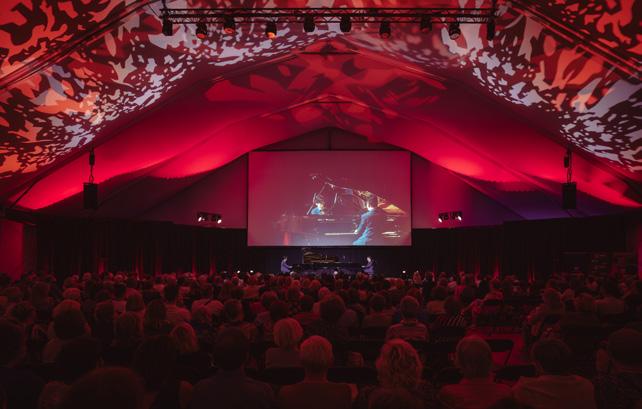
sented by Aga Zaryan and the Silesian Big Band, Danuta Błażejczyk and Andrzej Dąbrowski with the Chopin University Big Band.
Other highlights of the festival include a concert of greatest operetta hits sung by Grażyna Brodzińska and a musical project by The Heroes Orchestra which performs symphonic arrangements of music from video games.
This year, the organisers have partnered with the Korean Cultural Centre which will organise a concert by the NaMu band, showcasing traditional Korean instruments.
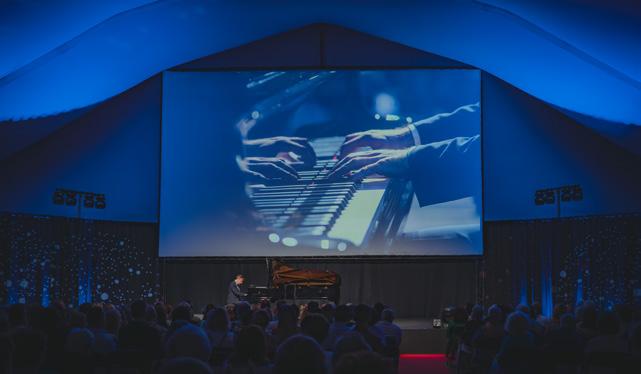
The Musical Gardens will close with “Wonder Women”, the latest recording project from Christina Pluhar and her ensemble L’Arpeggiata, which pays homage to female composers who had to fight for the right for creative expression throughout the centuries.
In keeping with the festival tradition, there will also be screenings of musical events from around the world, such as the “David Garret Iconic” music show or the unique project “Eden” by world-renowned American opera singer, Joyce DiDonato, filmed on the historic grounds of Ancient Olympia.
The festival is a project of the Musical Gardens Foundation, which has been organising the event since 2001. The foundation also participates in other musical events in Poland and internationally.
The full programme is available on the website https://www.ogrodymuzyczne.pl/program/
isitors to the seaside resort of Międzyzdroje on July 3-6, will have a fair chance to meet popular figures of Polish theatrical stage, cinema and television during the annual Festival of Stars.
The program of this year event features selected theatrical performances of the 2024/2025 season. On the first day, the festival audience will watch the play “Qui est Monsieur Schmitt?’’, an intriguing tragicomedy by Sébastien Thiéry which explores absurd situations and the human tendency towards opportunism.
Earlier, on the same day, the International House of Culture in Międzyzdroje will host the opening of an exhibition „Has na nowo (Has anew), by an acclaimed Polish graphic artist Andrzej Pągowski, who is also the author of this year’s festival poster. The exhibition will feature Pągowski’s posters for films by Wojciech Jerzy Has, a renowned Polish film director, screenwriter and producer.
The next day, Warsaw’s Capitol Theater will present the “Spirit Level”, a farce by an English playwright and screenwriter Pam Valentine, about a couple who drown in a boating accident and return as ghosts to haunt the country cottage where they lived to frighten away any would-be tenants.
The evening will be an opportunity to listen to a concert by Beata Rybotycka and Jacek Wójcicki from the legendary Piwnica pod Baranami (the Cellar Under the Rams), the most famous post-WWII Polish music cabaret that has made a lasting mark on the cultural map of the Polish southern city of Kraków.
On July 5, Miedzyzdroje festival will host two theatre performances. The first, “37 Postcards” by Michael McKeever is a crazy comedy, full of twists and turns, which follows young Avery Sutton and his fiancée as they return home from eight years in Europe.
The other play, “Separatka” by Joanna Szczepkowska, is about two women who end up in a single-patient hospital room, condemned to each other’s company. The differences in their characters and views lead to a series of funny misunderstandings.
On the same day, several popular Polish actors will imprint their hands in brass on a sidewalk known as Międzyzdroje’s Avenue of Stars.
So far, around 200 outstanding representatives of Polish culture have left their hand imprints there. This year, Henryk Talar, a highly respected Polish actor with a long and distinguished career in theatre, film, and television, is among those who will join the famed company.
Later in the day, a concert will be held in memory of the late Adam Myjak, a Polish sculptor who created all the brass plates with handprints on the Avenue of Stars.
On July 6, Henryk Talar will present a monodrama “78i co coś wincyj” (78 and more) by Zuzanna Talar-Sulowska, in which he takes on the role of the ‘Old Actor’ and talks about his life and career in a funny, sentimental way.
On the festival evenings, the Międzyzdroje amphitheatre will become a venue for two concerts by renowned Polish musicians. An iconic Polish pop rock music band Kombi, on the stage since late 70s, will perform on July 3. Dawid Kwiatkowski, one of the most popular singers of the young generation, will give a concert on July 4.
Other highlights of the festival include meetings with actors and autograph sessions for fans, as well as fairy tale reading sessions for children.
More information at: http://festiwalGwiazd.com.
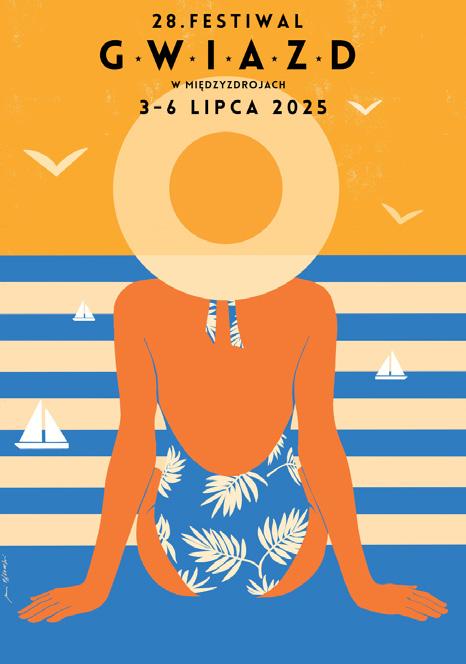
he new exhibition at the POLIN Museum of the History of Polish Jews, “1945. Not the End, Not the Beginning,” tells the post-war story of Polish Jews who survived the Holocaust from their perspective.
It marks the 80th anniversary of the end of World War II, in which almost 90 percent of Poland’s 3.5-million Jewish population was exterminated. After the war, the handful who survived faced loneliness, trauma, and hostility. This post-war reality is shown through the eyes of 14 people who, deprived of their loved ones and homes, tried to build a new life on the ruins of the old world.
Jews returning to their towns often found their homes occupied, their belongings missing. Their former neighbours greeted them with indifference, and sometimes hostility.
In the years 1944-1946 over 200,000 people of Jewish origin left Poland “They did not want to live in a cemetery, they could
not bear the feeling of loneliness and the looming danger of post-war anti-Semitism,” say the exhibition organisers
The exhibition shows the fates of those who, despite everything, decided to stay. It has been divided into several spaces. It starts with the Void created by “traces, places of oblivion, silence”. The second space, Returns, shows the search for loved ones, confrontation with post-war reality. The third, devoted to Memory, shows there was no place for Jewish mourning and that the monuments erected by Jews to the murdered were immediately profaned and destroyed. The fourth, Dilemmas, includes the fundamental one: to stay or to leave. The last Closing part, talks about “the end of rich, pluralistic Jewish life in Poland”.
Among the exhibits are original photographs, documents, letters, leaflets, and personal memorabilia.
On view till September 15.

Anew exhibition titled Spaces at Zachęta – the National Gallery of Art showcases the phenomenon of environment art, one of the most important and innovative trends in the second half of the 20th century.
The term environment refers to art of site-specific installations that capture the viewer physically and actively engages their senses, blurring the lines between observer and art. They utilize a variety of sensory elements and are designed in a way that allows the viewer to enter them and experience their light, sound, colour, and rhythm.
The exhibition presents unique projects of the classic figures in Polish modern art, who have changed the way we think about space, the viewer, and the exposition. Among them are Magdalena Abakanowicz, Wojciech Fangor, Henryk Stażewski and Maria Pinińska-Bereś, to name but a few.
On display are five reconstructions of environment installations; three of them are presented for the first time since their creation. They differ in their approach – from one rooted in painting or the concept, through sculpture, to attempts at captivating the viewer’s senses. The criterion of originality and experimentation is the common denominator for all of them.
Apart from reconstructions, the exposition also includes documentation of the work of artists such as Włodzimierz Borows-
ki, Józef Szajna, Zbigniew Dłubak, Edward Krasiński, Zbigniew Gostomski, and Zygmunt Targowski.
In Poland, the artistic community took up the trend of environment art quite early. The Study of Space (1958) by Wojciech Fangor and Stanisław Zamecznik is considered to be the first work of environment art in Poland. With its experiments with perspective, depth, and three-dimensionality, painting became the major driver for the development of environment art in the country. Another important impulse came from the cooperation between artists and architects in designing exhibitions, especially with Oskar and Zofia Hansens, and Stanisław Zamecznik.
The Spaces exhibition is more that an overview of historical projects. It is also meant to be a reflection on how environment art shaped new models of thinking about exposition, the relationship with the viewer, and the limits of the specific artistic disciplines. With the omnipresent immersive installations and digital media, the exhibition goes back to the sources of this phenomenon and allows to appreciate the pioneering approach of the creators, who overcame numerous limitations to freely explore experimentation in art.
On view through September 21.


The International Jazz in Ruins Festival is one of the most original music events in Poland, organised in the southern Polish city of Gliwice since 2004. This year it will take place between August 1 and 9.
For the first 15 years, the festival was held in the picturesque setting of the Victoria Theatre Ruins, a historic building from the late 19th century whose austere, brick interiors gave concerts a unique atmosphere. It was there that the idea of combining young jazz music with graphic art was born, an interdisciplinary platform for artists from all over the world.
In 2019, the festival moved to the current venue, the GZUT Model Hall, a more than 150-year-old post-industrial facility that was once used to create models of sculptures and casts, including for Poland’s famous monuments such as Warsaw Nike or the Silesian Insurgents Monument in Katowice). The new location not only preserved the spirit of the festival, but also enhanced it with new presentation and acoustic dimension.
In addition to concerts, the event also features poster exhibitions, workshops and meetings, which together create a unique artistic and social experience. The festival promotes mainly young, talented musicians and graphic designers, offering them a stage to present their work to the public.
The Jazz in Ruins festival is organised by the Silesian Jazz Club Music Association, the oldest jazz association in Poland, which has been supporting the development of young talent and popularising jazz in its various forms for years.
On the first day, August 1, the festival will host Maciej Fortuna Trio, who will present their recent material entitled “Baltic.” The audience will
also have an opportunity to listen to New Bone jazz quintet who will promote their new album “Sorrow.”
On the next day, August 2, the festival will feature Kajetan Galas Organ Spot performing compositions from their “Oitago” album as well as Marta Król & Paweł Tomaszewski Group offering their contemporary sound concepts of songs by the legendary band The Police.
On August 8, four young Austrian musicians from Alpha Trianguli band will present their debut album “Entering Zero Gravity.” The same day, Irek Głyk Quintet featuring Kinga Głyk will appear on the festival stage.
The highlight of the last day of the festival, August 9, will be a concert by Grażyna Auguścik and Jorgos Skolias who will perform songs written by Robert Świstelnicki.
Later, the stage will be taken over by Skalpel, a Polish nu jazz duo formed by Marcin Cichy and Igor Pudła.
More information about the festival can be found on the official website: www.jazzwruinach.pl.
Nasir and Philip Birkholz, founders of a Berlin-based, family-run luxury perfume house Birkholz Perfume Manufacture, have to come Warsaw’s Perfumery Quality Missala at the end of May to launch their brand in Poland. Guests of the event had unique opportunity, as the very first worldwide, to smell their new exclusive fragrance Sol e Samba, two weeks before the official launch. The Warsaw Voice spoke to Philip Birkholz , who announced plans to create a perfume dedicated to Warsaw which he described as “a city with a very cool vibe.”
Germany is not strongly associated with perfume but Birkholz has quickly managed to become a very significant player in the fragrance industry. How did it all start?
We founded the Birkholz Perfume Manufacture in 2017 with my father Nasyr, who had been in the beauty business for nearly 25 years and passed on his passion and knowledge to me and my younger brother Sven. But my first fascination with perfume began already when I was about five years old. I remember I dropped and broke a perfume bottle in the bathroom and was immediately captivated by the beautiful smell that actually lingered there for several days. Launching an own in-house brand was the fulfilment of our longtime dream to build our own production of perfume in our hometown where we could all, as family, work hand in hand on an every-day basis. We owe the name of our brand to the family name of my mother
The niche perfume market is quite saturated with a surge in new brands. What makes you so special ?
The backbone of our business is a strong family bond you cannot break. Perfume

manufacture is for us a family affair, the beauty of working together as a team with shared family values and passion to offer a unique experience to our customers. We believe there is a perfect perfume for everyone so we strive to create a fragrance that truly resonates with a person. It’s a combination of the art of perfumery with creating an experience for every customer. So it is important to listen carefully to a customer who comes to buy our perfumes, to find out what their needs really are. And this is what we do. I always say to my sales team: take your time, if it takes an hour then it takes an hour.
You are behind all your perfume creations and refer to yourself as a perfume sommelier, the term mostly associated with wine. Why? A good friend of mine is a wine sommelier. I met with him for a meal at the time when we were planning to launch the brand. He was advising me which wine goes best with the dish and told me some good stories around it. At some point it came to me that I could do the same for perfumes. Perfume is subjective, either you like it or you don’t but you can create a story around it. If there is no story, especially in the niche, it will not succeed.

Fragrances are about emotions, memories, lifestyle. They have to touch the soul and the heart. This is our vision, our credo. So we want to create stories behind each perfume that our customers can connect with, like those about some special moments in life: falling in love for the first time, the first heartbreak, some memorable journeys. Each fragrance must tell its own unique story and therefore we have different collections, each of them special in their own way.
How many collections do you have?
A total of five. The first, Classic Collection, was launched in 2017 as the entry-level collection for the consumers who did not know our brand yet. It was designed as a fragrance journey around the world from Berlin to Ibiza and Los Angeles where people could engage in my personal stories and create their own. It is also designed for layering.
The Woody Collection was inspired by nature and natural ingredients bringing a close connection to our family because Birkholz translates as birchwood. Developed with some unusual notes combined with woods it has very royal and bold fragrances.
The Italian and French Collections are a homage to two countries strongly associated with perfume and beauty. Both were inspired by a road trip I did through Italy and France, from Milano to Noto and from Paris to Corsica.
The Black Collection is our most exclusive line of six opulent, mysterious and intense perfumes with a fragrance oil content of 25 percent, which come in a black lacquered wooden box.
WE BELIEVE THERE IS A PERFECT PERFUME FOR EVERYONE SO WE STRIVE TO CREATE A FRAGRANCE THAT TRULY RESONATES WITH A PERSON. IT’S A COMBINATION OF THE ART OF PERFUMERY WITH CREATING AN EXPERIENCE FOR EVERY CUSTOMER
You said that the Classic Collection is designed for layering. Can you elaborate on this?
With perfume layering, that is the art of combining two or more fragrances, we can be truly creative. It allows to customise a fragrance to your individual taste, mood or occasion. And I would say our Classic Collection is perfect for this.
But I would not recommend layering for, for example, our Woody Collection because it is so special, so individual already that if you layer it over and over it would be such a mix-up that it would lose the soul of the original fragrance.
I am also a little sceptical about combining perfumes from different brands. I know that a lot people do it but I am very careful about it because every brand has or should have their own DNA. Our DNA is to have a perfume that is intense but not overwhelming, not very loud. Perfume is for yourself in the first place, to make you feel good, to enhance this feeling, to give it a boost.
Do you have any favourite perfumes in your extensive portfolio?
It’s difficult to answer because when you create them yourself you have to decide as a parent which is your favourite child and you don’t want to do that. So I would answer it a little differently.
If I were in an emergency, like the house is on fire, and had to choose one then it would be the first perfume I created – Berlin Soul. It’s a whisky-hazelnut fragrance with sandalwood and leather, a dedication to Berlin, to my hometown, to my family, a very personal fragrance.
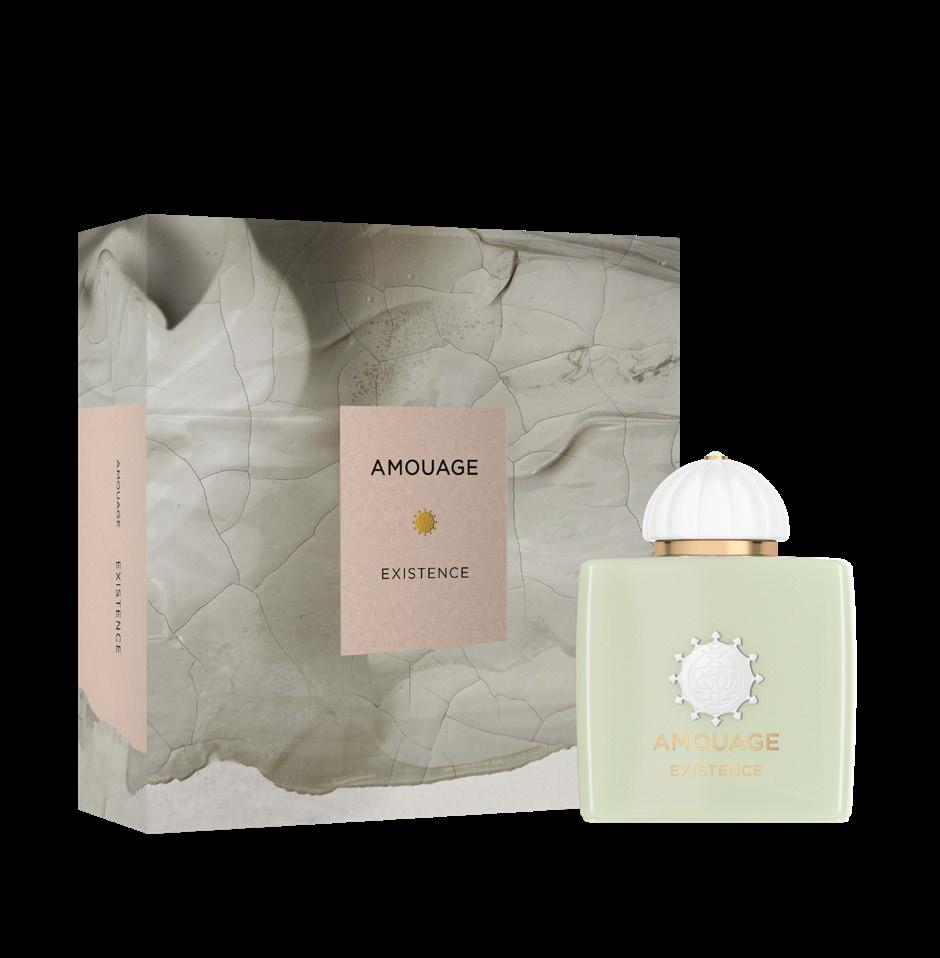
- Decision and Existence. Both, meticulously crafted by the renowned perfumer Quentin Bisch, feature frankincense, an ingredient that connects the living and the divine.
The aromatic-woody Decision is intended to embody the power of conscious choice. It opens with an olfactory bolt of lightning that disperses the darkness of uncertainty, an effect achieved through a combination of the cool woodiness and citrus-mineral sparkle of Bergamot, Juniper Berries, Frankincense and Myrrh. As the scent unfolds, Atlas Cedarwood

1
decisive acceptance.
With a 33% oil concentration and a fiveweek ageing process, including three weeks of maceration and two of maturation, this distinctive scent has exceptional longevity.
The floral-musky Existence is a scented vision of infinity inviting the wearer on a journey through tranquility and meditation. Featuring a luminous top note of Lily of the Valley, elevated by the spiritual depth of Frankincense, the fragrance evokes a feeling of transcendence. Complemented by Aldehydes, which enhance
the effect of pristine whiteness, and a touch of Rose, which evokes the impression of a living, breathing physicality. At the base, White Musk adds the ethereal aspect to the composition while Benzoin anchors the fragrance, reconnecting it to the textured richness of the earth below.
With a 20% oil concentration and four weeks of ageing, including two weeks of maceration and two weeks of maturation, Existence is a scent of stillness and strength.
Both EDPs are housed in iconic Amouage bottles, with motifs inspired by Omani culture. The ash-gray flacon reflects Decision’s dazzling character, while the lime green shade of Existence’s bottle


reflects the perfume’s more ethereal nature. The outer packaging features sensual artwork by Belgian artist Louise Mertens. Her creation for Decision features a bold, eye-catching motif of a cross-section of tree bark, while the one for Existence it is a dreamlike, abstract vision of a canopy of clouds or an endless sea.
Gong Eau de Parfum is the latest creation by Floraïku Paris, the French perfume house inspired by Japanese sophistication, traditions and ceremonies. This fresh ambery fragrance owes its name to one of its ingredients, an accord of the dorayaki,
a small, filled Japanese cake, a popular treat served at teatime. Its round shape resembles that of a gong, a ritual instrument, whose sound soothes, generates harmony and leads to a state of inner peace and joy. The new scent is an invitation to experience this refined enjoyment of tea ceremony through the notes of the composition that resonate on one’s skin.
A delightful opening Gong captures the senses with subtle notes of Italian Mandarin, Pink Pepper and Yuzu. Then the fragrance softens with a tender heart of the soft biscuit spiced with Black Pepper and enhanced by a warm, balsamic drydown of Siam Benzoin and Wood.
Lucius Extrait de Parfum from the French perfumery house Fragrance du Bois has been crafted for the modern champion to awaken their innate strength.
This aromatic woody perfume opens with a bold surge of refreshing notes of Bergamot, Mandarin, and Pink Pepper, igniting readiness to face challenges and conquer the world. The fragrance unfurls to reveal a commanding heart of intense Cedarwood and Orange Blossom, which cohabitate harmoniously to create an aura of resilience and determination.
The base is a deep blend of Vetiver, robust Tonka Bean and dry Amber which leaves a lingering, enveloping trail of self-confidence.



4/ Smells Like Music

Black Moonlight and NeoRio are two new seductive fragrances created by the Italian luxury perfume label Xerjoff in collaboration with the most iconic and influential bands of the 1980s Duran Duran.
Bearing the same name as Duran Duran’s 2023 single, Black Moonlight is an intense Amber oriental perfume with an incense-balsamic soul, inspired by darker and more introspective aspects of the band’s sound and style.
The composition stirs the senses with vibrant top notes of Bergamot, Mandarin and Cardamon, tempered by a spicy touch of Saffron. At the heart of the fragrance, Lavender, Ylang-ylang and Myrrh mingle with the exotic appeal of Sambac Jasmine and Hazelnut. The earthy depth of Patchouli and Vetiver, enriched by the balsamic sweetness of Tonka Bean, Benzoin and Labdanum, create an envelop-
ing and sensual base. An elegant nod to Duran Duran’s talent for fusing art, emotion and innovation.
Inspired by Duran Duran’s second album, NeoRio is a tribute to the band’s limitless creativity and boundary-breaking energy.
It opens with an exhilarating blend of Candied Fig and Rum, brightened by the crispy freshness of Elemi Absolute with the added depth of Spanish cistus oil. The heart reveals a vibrant warmth of Saffron intertwining with the soft elegance of Rose Oil, before settling into a comforting and sensual base of Tonka Bean and alluring Peruvian balsam.
NeoRio is presented in four bright and fun neon colour versions of its iconic flacon to mirror the free-spirited vibe of the composition. You can choose Fluo Pink, Fluo Yellow, Fluo Green or Fluo Orange, whichever best suits your style, mood or wardrobe.

Simon Le Bon’s autograph on the flacon and coffret adds another fine touch to the whole artistic experience.
5/ Delicacy that grabs attention Melogold is a new oriental jewel in the Rose Arabia collection by Abu Dhabi brand Widian. The composition created by master perfumer Nathalie Lorson is an exciting interplay between fruity freshness and elegant sensuality of leather notes.
The top notes reveal a sparkling bite of juicy Grapefruit accompanied by aromatic Juniper Berries and a touch of the warm, golden spice of Saffron which lends the fragrance a noble intensity. This vibrant opening is followed by an unexpected dissonance in the heart of the composition when the elegant delicacy of Violet meets sensual Leather, while sweet Raspberries bridge these opposites into a perfect symbiosis. In the base, Cashmeran Vetiver interweave


with Musk to create an impression of untamed sophistication.
6/ Celebrating spirit of Marrakech
Boheme Chic is one of seven masterpiece fragrances in the first perfume collection, “The Moroccan Vibes,” from Marrakech Impérial, the first high perfumery house in Morocco. Created by the Italian-Moroccan couple Kenza Snoussi and Massimo Di Nardo in 2020, the brand seeks to pay homage to the rich heritage of Marrakech offering perfumes that capture its magical and mystical essence.
Bohème Chic is a sumptuous Floriental Powdery Amber fragrance that captures the city’s legacy as a muse for designers, artists, and creators. This exquisite fragrance embodies the bohemian chic lifestyle, a blend of cultures, colours, and sounds that sparks bold dreams and limitless creativity. The fragrance opens with notes of Ylang-Ylang and Date, followed
by a powdery, suave and balsamic floral accord of Iris, Heliotrope and Rice Powder, supported by musky notes of Amber and creamy Vanilla in the base.
All seven captivating fragrances in The Moroccan Vibesline: Bohème Chic, Arabian Leather, Take Me Back To Marrakech, Magie Rouge, Oud Kasbah Royal, Les Nuits De Marrakech and Atlas Wood have been crafted by the master perfumer Christian Carbonnel.
The bottle and cap of Marrakech Impérial were designed by Youssef Chajai, a Moroccan architect, and inspired by the doors and walls of the imperial palaces of Marrakech.
7/ Be safe under the sun
C+C Vitamin SPF 50 Dry Touch Sunscreen Fluid by Natura Bissé has earned the Seal of Recommendation for safe and effective sun protection from the US independent research institution Skin Cancer Founda-
tion, a guarantee that the product meets the rigorous requirements of dermatology and photobiology experts.
This light and water-resistant sunscreen not only safeguards your skin against sun damage and skin cancer but also helps prevent premature aging.
It includes an effective blend of sun filters providing high protection against UVA and UVB radiation, combined with powerful antioxidants like vitamin C and moisturising ingredients to combat photoaging and reveal a smoother, suppler and radiant complexion.
C+C Vitamin Dry Touch Sunscreen Fluid SPF50 has been created with care for the natural environment of the seas and oceans. Its formula is biodegradable and coral reef-friendly.
Diamond Luminous Oil-free Brillant Sun Protection SPF50 PA+++ is another product by Natura Bissé that has been recognised by Skin Cancer Foundation.
Compiled by Bartosz Grzybiński


1/ Gaming on the go – nubia Neo 3 5G
The Nubia Neo 3 5G is the perfect smartphone for gamers. Its futuristic design and carefully crafted details give it a unique character. Two additional capacitive buttons, located on the case so that they can be operated naturally with your index fingers, work perfectly as triggers familiar from gamepads. Thanks to the AI Game Space 3.0 feature set, the nubia Neo 3 5G offers a range of solutions useful for various types of gaming. The smartphone is equipped with a Unisoc T8300 5G processor and 20 GB of dynamic RAM.
The 5200 mAh battery with 33 W fast charging guarantees long-lasting use on
a single charge. The Neovision AI photography system with a 50 MP dual camera allows you to capture every moment and create unforgettable, high-quality photos. www.zteshop.pl
2/ realme GT 7 Series
realme unveiled the GT 7 series in Paris, including the GT 7 Dream Edition model, developed with the Aston Martin F1 team. The GT 7 offers top-of-the-range specifications: a 7000 mAh battery, 120 W charging, Dimensity 9400e chip and IceSense Graphene cooling. It is distinguished by AI Planner, a 50 MP camera, a 6000 nits AMOLED screen and IP69

water resistance. The Dream Edition impresses with its F1-inspired design. The GT 7T with Dimensity 8400-MAX also offers top performance. The series supports AI Gemini from Google. The last new feature is the Buds Air 7 Pro headphones with Live AI Translator. www.realme.com/pl
3/ MiVue MP30 GPS motorcycle camera
The camera has been designed for motorcyclists who value safety and high-quality recordings. Thanks to the use of two 2.5K resolution lenses, one facing forward and the other facing backward, the camera allows you to record the full picture of the



situation on the road. HDR technology allows it to capture better-lit scenes, which significantly improves the legibility of license plates and other important details, even in difficult lighting conditions, such as when driving after dark or in bright sunlight. The ability to record at 60 fps guarantees smooth images. The camera turns on automatically when connected to a helmet or mount, so the rider does not have to remember to turn it on before each trip.

The camera is equipped with a 3200 mAh battery that allows up to 4.5 hours of continuous recording. IP67 waterproof rating means the device is resistant to
dust, mud, and heavy rain. With a builtin Wi-Fi module, Mio MiVue MP30 users can easily sync recordings to their smartphone in real time, while the GPS module allows location and speed to be recorded. This feature can be crucial for analyzing traffic accidents or disputes about the route. The Mio camera comes with a 3-year warranty.
www.mio.com/pl_pl
4/ ZTE U30 Air: pocket-sized 5G at the best price
ZTE is launching the U30 Air, a modern mobile router offering ultra-fast 5G connectivity. The device also provides
Wi-Fi speeds of up to 867 Mbps, allowing multiple users to enjoy comfortable internet access. Network support is extremely simple – just one touch of the NFC module is all it takes to connect to the internet. Thanks to its high-capacity 4500 mAh battery, the router can operate for up to 10 hours without recharging. The U30 Air 5G is the perfect solution for those who value mobility, reliability, and aesthetic design. It is ideal for travel, remote work, or everyday use, wherever fast and stable network access is important. This model is the best-priced 5G router in Poland.
www.zteshop.pl
Story and photos by Bartosz Grzybiński
Of all the automotive brands, Volvo is most associated with safety and station wagons. The V90 model is the quintessence of decades of experience in offering cars with this body type.
Looking at the car, it is hard to believe that it has been on the market for almost a decade. The Volvo V90 made its debut in 2016 at the spring Geneva Motor Show, attracting great interest from visitors. The car was built on the SPA (Scalable Product Architecture) platform, which was developed for the second generation of the largest SUV, the XC90. This gave designers and engineers great freedom in creating a large car with a station wagon body, with a length of 4.93 meters and a wheelbase of 2.94 meters.



THE 2020 FACELIFT WAS MOSTLY COSMETIC. A MORE IMPORTANT FEATURE INTRODUCED THIS YEAR WAS THE PLUG-IN HYBRID DRIVE
The styling of the V90 is reminiscent of other Volvo models. Characteristic elements such as T-shaped LED headlights (Thor’s hammer), the shape of the air intake with the large brand logo, and the rear lights extending high up onto the C-shaped pillar and tailgate have also been used in the V90. With a relatively low height (1.47 m) and long length, the body appears even more slender, especially as the ground clearance is just over 15 centimeters. The silhouette of the car, set on 20-inch alloy wheels and low-profile tires, is very dynamic and stands out among competing executive estate models.
The interior is very spacious and can easily accommodate five adult passengers. They have a 560-liter trunk at their disposal. If necessary, its size can be increased to 1,526 liters by folding the rear seat backs. Even with a maximum load, the car handles excellently. This is thanks to the active suspension, which uses air suspension on the rear axle. The comfort and safety equipment is comprehensive and includes, among other things, leather upholstery in amber-colored Nappa leather, heated and ventilated front seats with massage function, four-zone air conditioning,

a 19-speaker Bowers & Wilkins audio system, and many safety assistance systems using the well-known City Safety and Run-off Road Migration technologies - the world’s first system that prevents collisions associated with driving off the road at speeds of 65-140 km/h. The system constantly monitors and corrects the direction of travel and can also stop the car in case of danger.
The 2020 facelift was mostly cosmetic. A more important feature introduced this year was the plug-in hybrid drive, which combines a gasoline engine and a 48-volt electric motor with a battery that can be charged from a power outlet. The hybrid drive is available in two versions: the T6 eAWD
Plug-in-Hybrid, in which a turbocharged 253 hp gasoline engine works with a 145 hp electric motor, and the top-ofthe-range T8 eAWD Plug-in Hybrid (310+145 hp), available from 2022. The total power of this system is 455 hp, and the total torque is 709 Newton meters. The combustion engine drives the front wheels, while the electric motor drives the rear axle, and the electric drive alone can cover a distance of approximately 40 kilometers. Although the car weighs over two tons, it offers very good performance. Acceleration to 100 km/h takes only 4.8 seconds. As in all models of the brand, the maximum speed is electronically limited to 180 km/h. Power is transmitted through an 8-speed automatic
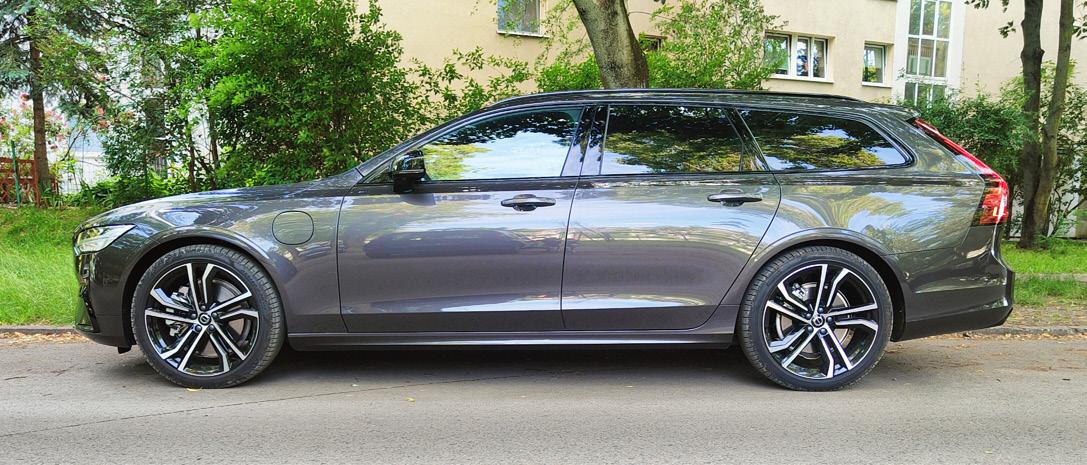
WHICH WAS UNAMBIGUOUSLY ASSOCIATED WITH VOLVO, AND STATION WAGONS
transmission, and a crystal gear lever from Orrefors adds a touch of style to the entire center console.
For many decades, the brand was perceived through two prisms: safety, which was unambiguously associated with Volvo, and station wagons. Which car enthusiast does not remember the angular, spacious, and safe Volvos, starting with the 1953 Duett, through the Amazon (1962), Volvo 145 (1967), P1800 ES (1971), Volvo 940/960 (1990), Volvo 850 (1993), the V series models, i.e. V70, V40, V50, V60, and all the way up to the V90. Today, the brand continues these traditions by offering, alongside the most popular models in the SUV segment, elegant, fast, and safe station wagon models, such as the V90 presented here. This is very important news, as production of this model is scheduled to end this fall and be replaced by the fully electric ES90, but in a fastback body style. Could this be the end of the station wagon era?


Within the next few years, 2-3 projects related to the construction of production and material facilities for semiconductors will be launched in Poland. The impetus for this will be a state support program for the sector worth at least EUR 1.5 billion.
The Ministry of Digital Affairs has adopted a document which assumes that industrial investments in this sector will be attracted to Poland. According to the draft, 2-3 large projects “with added value in the range of EUR 300-600 million” are to appear by 2030. However, factories producing only advanced integrated circuits are not being considered; the ministry is targeting areas such as back-end production and materials necessary for production.
The document “Poland in the game for the future – policy for the semiconductor sector 2025+” sets out the general directions of the state’s activities for the development of one of the most demanding and at the same time most promising sectors of the modern economy. As Deputy Minister of Digital Affairs Dariusz Standerski explains, the final version of the policy is the result of extensive consultations with industry and the scientific community.
“The state plays the role of a full partner in this process – an investor, user, and coordinator, which is essential for strengthening the country’s
technological sovereignty and competitiveness,” he said, pointing out that the document presents “a vision and ways to support microelectronics as a strategic sector,” important both for technological sovereignty and for domestic “industrial ambitions.”
The strategy is based on seven pillars: infrastructure, state impetus (including the creation of a platform connecting the domestic semiconductor sector with the public and industrial sectors by the second quarter of 2026), regional and international cooperation, investment and financing, human resources and education, as well as energy and water (e.g. the idea of creating special energy zones based on access to stable and low-emission energy sources, which are part of the country’s investment offer) and chemicals and raw materials (implementation of the EU plan to ensure that by 2030 at least 25% of the demand for strategic raw materials is covered by recycling).
In the first aspect, the document focuses both on existing infrastructure and on infrastructure planned to be built as part of new public and private investments. The policy assumes that infrastructure should support three interrelated state policy objectives. Firstly, Poland is to create conditions for breakthrough innovations such as inte-

grated photonics, wide-band-gap materials and micro-systems. Secondly, the country is to join European and global value chains that include chip design, components, and production systems. Thirdly, the state is to develop strategic capabilities related to digital security, energy, and defense technologies.
The government hopes that this approach will help at least double the still small share of the semiconductor sector in the economy in the coming years.
The key objective is to attract investors. “We want to create an environment that will help develop domestic industry and at the same time increase Poland’s attractiveness to foreign investors,” the ministry wrote.
The ministry recommends extending and adapting national support programs for investments in the semiconductor sector—at a level of at least EUR 1.5 billion—and “developing mechanisms to help cover operating costs, support technology transfer, and ensure stable conditions for investors.” Furthermore, a trilateral memorandum with the Czech Republic and Germany (Saxony) on the creation of a “semiconductor triangle” is to be signed by the fourth quarter. The aim is to exploit the potential of neighboring regions to create a so-called technology micro-region that will focus efforts on joint investment, research, and education in the semiconductor sector.
Public consultations lasted almost a month and involved 38 entities: companies, public institutions, industry organizations, and representatives of science. A total of 356 proposals for changes were submitted, covering technical, infrastructural, legal, and editorial issues.
Estimates indicate that there are about 20 companies in Poland operating in traditional silicon microelectronics and over 200 entities in related areas, such as photonics, design, materials and solutions supporting chip production. According to estimates, the electronics and microelectronics sector in Poland employs approximately 12,000-15,000 people, of whom 1,500 specialize in the design of integrated circuits and advanced components.

Until the very last moment, Poland’s national carrier was considering whether to choose the Airbus A220 or the Embraer E195-E2. Ultimately, the French manufacturer won the contract.
This is the first order placed with Airbus in LOT’s recent history. The agreement was signed on June 16, during the international air show in Paris at Le Bourget airport, in the presence of Infrastructure Minister Dariusz Klimczak and French Transport Minister Philippe Tabarot.
The order is for the delivery of 40 Airbus A220 aircraft in the -100 and -300 versions between 2027 and 2031. In addition, the Polish carrier has secured the option and right to purchase a further 44 aircraft from the manufacturer.
The parties did not disclose the value of the transaction. All that is known is that the Airbus 220 in the -100 version has a list price of USD 81.5 million. In the larger -300 version, it rises to USD 91.5 million. Usually, in the case of larger orders, which include the one placed by LOT, the manufacturer offers a dis-
count of 25% to 50% off the list price. The Embraer E195-E2 has a list price of USD 60 million and is likely to offer similar discounts for large transactions.
LOT’s A220-100/300 aircraft will be powered by PW1500G engines from the American manufacturer Pratt & Whitney. LOT signed a separate agreement in Paris for their delivery. It covers not only the delivery of the engines, but also cooperation in the operation of the regional aircraft fleet.
The Airbus A220 is a regional jet that can carry between 100 and 160 passengers, depending on the variant. Its maximum range is 6,700 kilometers, which means it will be able to fly to all airports served by LOT in Europe. The aircraft is low-emission, generates less noise, and fuel consumption per passenger is a quarter lower than previous generations of aircraft operated by LOT - the Embraer E-175 and E-195.
“The Airbus A220 family aircraft, which will begin joining the LOT fleet in 2027, open up new opportunities for
development and growth, which are the pillars of our strategy,” said LOT CEO Michał Fijoł after signing the agreement.
“The A220 will play a key role in the modernization of LOT’s fleet and its network expansion strategy. The A220-100 and A220-300 aircraft are the ideal combination for these needs,” said Benoit de Saint-Exupery, Airbus Vice President of Commercial Sales, quoted in a press release.
In its configuration for PLL LOT, the Airbus A220 will be equipped with Recaro seats manufactured in Świebodzin. Passenger amenities will include mobile device holders, 60W USB-C ports for fast charging of mobile phones and laptops, and cup holders. LOT also promises that internet will be available on board the A220. With the delivery of the first aircraft ordered on June 16, LOT will begin consolidating its regional fleet. Ultimately, after the older generation of regional aircraft are withdrawn, it will consist exclusively of A220-100 and -300 aircraft.
Polish sales to its eastern neighbor are growing dynamically, mainly due to the needs of the front. Domestic companies may also benefit after the end of the war.
Ukraine’s share in Polish exports rose from 1.4% in April 2015 to 3.6% in April 2025, according to data from the Central Statistical Office (GUS). Ukraine entered the group of the 10 largest recipients of Polish goods at the end of 2022 and is currently in 7th place.
Analysts at the Polish Economic Institute (PIE) point out that exports from Central European countries to Ukraine have been steadily increasing since 2017. Since then, they have increased 2.5 times: from EUR 9.8 billion to EUR 24 billion at the end of 2024. Between 2021 and 2024, total sales rose by about 60%. In the case of Poland, this growth was particularly dynamic and exceeded 100%.
“Poland has strengthened its position as a key trading partner of Ukraine, becoming the second largest supplier of goods to that country, ahead of Germany and second only to China,” wrote PIE economists.
The war has not stopped demand for imported goods in Ukraine; in fact, in many categories, it has boosted trade. According to the institute’s calculations, the CEE region accounted for 18% of Ukraine’s total imports before 2022 (including 7.5% from Poland), and by the end of 2024, this figure will rise to 26% (of which Poland will account for 11%).
A significant part of the growth in Polish exports to Ukraine was generated in two areas directly related to the war effort. These are sales of weapons and ammunition, which increased more than 100-fold compared to 2021, and sales of fuels and derivatives, which rose almost 10-fold.
In the first four months of the year, Ukraine purchased ammunition in the form of bombs, grenades, torpedoes, mines, and missiles worth PLN 2.09 billion from Poland, which accounted for 11.6% of the total value of exports. Broken down into subcategories, this was the largest item in Polish exports to Ukraine. In second place was the category comprising petroleum oils and oils obtained
from bituminous minerals (PLN 2.06 billion, 11.4%), followed by drones (PLN 1.0 billion, 6%).
Poland sells the most mineral products, vehicles and aircraft, as well as machinery, equipment and electronics to Ukraine. Weapons and ammunition rank fourth, ahead of chemical products, textiles and food products.
War losses suffered by factories and production plants are also increasing demand for “non-war” goods from Poland.
In the first four months of the year, sales to eastern neighbor amounted to PLN 18.0 billion. This is 4% more than in the same period last year and 418% more than 10 years ago. After April, the trade balance with Ukraine was positive and amounted to PLN 11.6 billion. Last year, Poland closed with a surplus of PLN 36.1 billion: goods worth PLN 56.6 billion were sold and goods worth PLN 20.5 billion were purchased. Poland has a better trade balance only with Germany (PLN 119 billion), the United Kingdom (PLN 53.9 billion) and the Czech Republic (PLN 43.5 billion).
The trade balance with Ukraine after the end of the war will depend, among other things, on the pace and extent of the reconstruction of Ukrainian production capacity, the population with which the country will enter the post-war period, and the regulations governing the flow of goods and services between the EU and Ukraine. Analysts note that the expected further liberalization of trade and, in the longer term, Ukraine’s accession to the EU and thus its entry into the EU market will further increase demand
for Polish goods. The PIE estimates that Ukraine’s accession to the EU in the next two to three years will contribute to an increase in the country’s import needs by almost one-fifth.
Ukraine’s accession to the EU is more likely to result in an increase in Ukrainian imports than exports. This would be the result of joining the customs union and accelerated economic growth and income levels. PIE economists estimate that, depending on the pace of convergence, total GDP growth in the medium term would range from 1.7% in a pessimistic scenario to 26% in an optimistic scenario.
The largest increase in the value of imports would occur in dairy products (by 14-39%) and meat products (by 3266%), i.e. goods that currently enjoy the highest level of protection. Among other manufactured goods, the largest increase in imports would be in motor vehicles and parts (over 30%) and light industry products, including leather goods, wood products, paper products, metal products, and transport equipment (an increase of over 21%).
PIE experts estimate that of all the countries in the region, the Polish economy would benefit most from Ukraine’s accession to the EU: its GDP would increase by 0.17%. The trade balance with Ukraine would not suffer, as the report indicates that the impetus for growth in imports from Ukraine in the countries of the region would be “most likely negligible.”
In addition to the pace of economic convergence, the scale of foreign investment inflows will also be a significant factor in changes in Ukraine’s foreign trade.
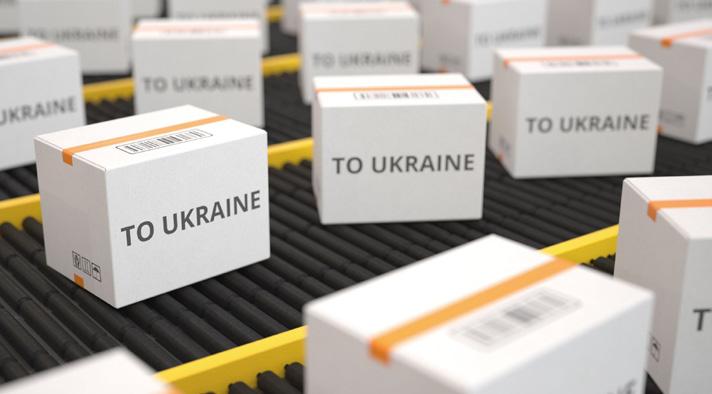

The Skarżysko-Kamienna-based company has completed part of its investment in the so-called Project 400. The delay was three years.
”We are very proud to open our new production hall. Thanks to full automation, we are increasing our production capacity from 50 to 250 million pieces of ammunition. We will produce one million pieces every production day,” announced Renata Gruszczyńska, CEO of Mesko, a company belonging to the Polish Armaments Group (PGZ). Prime Minister Donald Tusk added that the government is very keen to ensure that weapons manufactured in Poland are also exported.
Project 400 has been underway since 2019 and is worth over PLN 460 million. According to Mesko employees, “the scope of the investment includes over 1,000 machines and devices and over 20 facilities located in Skarzysko-Kamienna and Pionki. The main objective of the project is to increase production capacity for small-caliber, medium-caliber, and large-caliber ammunition and rockets, as well as to acquire expertise in the
production of multi-base propellants and self-igniting cartridge cases.”
The original plans were for the entire project to be completed in 2022. It will most likely be completed by the end of this year. In addition to the COVID-19 pandemic, war, and radical price increases, poor management and constant changes in the company’s management board also contributed to the delay.
Mesko is also implementing “Project 44.7,” which should enable it to “gain the capacity to produce modified gunpowder needed in the manufacture of various calibers of ammunition.” Today, Mesko has the expertise to produce single-base and partially modified single-base gunpowder.
Although the Polish arms industry has reached a whole new level in the production of small-caliber ammunition, the production of large-caliber ammunition—155 mm artillery and 120 mm tank ammunition—remains an unresolved problem.
“Our government is very consistent in strengthening the Polish defense industry and the Armed Forces. A strong defense industry is an
element of strengthening the state’s power. It is no secret that state-owned companies are the main axis of the defense industry’s modernization,” said Jakub Jaworowski, Minister of State Assets. “Another major project is the development of large-caliber ammunition production capabilities. PGZ has submitted applications for co-financing to the Ministry’s Capital Investment Fund. I hope that the applications will be considered by the end of June and that within three years we will be able to produce 150,000-200,000 pieces of ammunition,” he added.
The value of these applications is approximately PLN 2.4 billion. Any day now, the Polish Armaments Group should also select a foreign partner from whom it will most likely purchase a license to produce missiles with a range of 40 km. Talks have been held with partners from the Czech Republic and Slovakia (CSG), Turkey (MKE), France and Germany (KNDS), and the United Kingdom (BAE Systems). This production will most likely be located in central-western Poland.
One of the most important industrial centers not only in Poland but in the entire Central and Eastern European region may be established on the Baltic Sea coast. Pomerania is strengthening its position as an important region on the country’s logistics map.
The region continues to offer access to specialists who are improving their qualifications thanks to new thematic courses being launched at universities in the Tri-City. It also remains competitive in terms of labor costs.
Such large investments in energy translate into increased demand for logistics facilities, including specialized warehouse space. In the first quarter, nearly 18,500 sq. m. of warehouse space was completed in the Pomeranian Province, and 15,500 sq. m. in the West Pomeranian Province. In 2024 as a whole, developers delivered nearly 294,000 sq. m. of modern space in the Tri-City, while no new warehouses were built in the West Pomeranian Province. Tenant inter-
est in both the Tri-City and the West Pomeranian region remains stable. In the first quarter of this year, companies leased nearly 92,000 sq. m. in the Tri-City and 73,000 sq. m. in the West Pomeranian region, while in 2024 as a whole, this figure was almost 290,000 sq. m. in the Tri-City and 174,000 sq. m. in the West Pomeranian region. At the end of March this year, less than 100,000 sq. m. was under construction in each of these provinces, according to data from Newmark Polska.
Warehouse developers operating in the north of the country are interested not only in cooperation with manufacturing companies, but also with the energy sector, which is reporting growing demand for warehouse space. However, meeting the needs of tenants in this industry requires both significant capital resources and specialist know-how. Traditional warehouses offer thousands of square meters of modern, production- or storage-adapted in-
door space. Meanwhile, companies from the renewable energy sector, such as wind turbine manufacturers, need a small covered hall and huge paved yards prepared for the storage of large and heavy components. This is a completely different type of investment and requires different budgeting. Nevertheless, companies that have already secured land in this region will undoubtedly benefit from the changes taking place. The most active developers serving the energy sector in Pomerania include Panattoni, which cooperates with the Accolade fund, and 7R.
Land in the Pomerania region is worth its weight in gold. Demand is huge. The development of the energy sector – from wind and solar farms to planned nuclear investments – means that suitably prepared plots are becoming a scarce resource. In addition, operators of future energy storage facilities are also competing with developers for land near wind farms.

Despite the uncertain situation in global trade, Polish ports are preparing investments that will allow them to triple container trans-shipments. After Gdańsk, a large container port is to start operating in Świnoujście in four years. However, the expansion of Gdynia may be significantly delayed.
A PLN 2 billion investment in the port of Gdańsk has just been completed. This is the third part of the 18-yearold Baltic Hub container terminal, which is owned by three owners: Singaporean operator PSA International (40%), the Polish Development Fund (30%) and Australian fund IFM Global Infrastructure Fund (30%).
A consortium of Budimex and Deme has built yards with giant cranes as tall as 10-story buildings on a 36-hectare peninsula artificially constructed in the Gulf of Gdańsk. The investment will increase annual transshipment capacity by half, from 3 million to 4.5 million TEU (20-foot containers). This has strengthened Baltic Hub’s leading position in the Baltic Sea.
In the case of maritime transport, the number of containers transported from the Far East continues to grow. In the first five months of 2025, Baltic Hub increased its trans-shipments by several percent. Four times a week, large ships capable of carrying up to approx. 25,000 containers, and their loading and unloading takes a total of three days. Their transport to ports also generates huge profits for the State Treasury. In 2024, the Polish budget was enriched by as much as PLN 56 billion from taxes on goods transshipped in the port of Gdańsk. Further investment is needed. It would be useful to improve rail access capacity, as currently only about one-third of the containers handled at Baltic Hub can be transported by train. The construction of a new railway line and a bridge over the Dead Vistula River is important. However, the planned investment has been protested by landowners.
Gdynia also dreams of container transshipment on a scale almost equal to that of Gdańsk. For several years, proceedings have been underway to build an external port, the main part
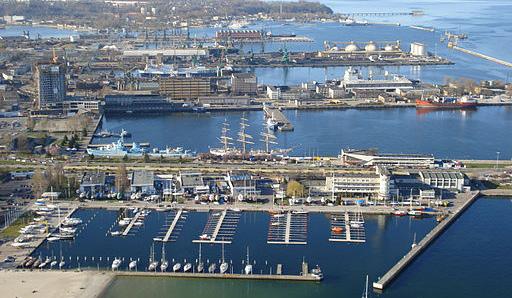
of which is to be a deep-water container terminal with a transshipment capacity of 2.5 million TEU per year. The investment is to be implemented as a public-private partnership. The funds for the implementation of most of the tasks (over PLN 5 billion) are to be provided by a private investor. In return, the investor will earn money from trans-shipments for several decades. The Port of Gdynia Authority has already shortlisted four players from which the winner will be selected. However, the deadline for opening bids in the tender has already been postponed five times.
Companies have doubts as to whether the investment will be fully profitable. The port is trying to dispel these doubts and is revising the terms of the tender. A few months ago, it agreed to extend the concession period for the external port from 38 to 44 years. In the background, there is still the sensitive issue of the Chinese lessee of part of the port, Hutchison Ports, which made headlines when it refused to allow weapons sent by the US to Ukraine to be unloaded in Gdynia. In March, however, there was a chance that the Chinese would sell the port to the American fund BlackRock and the world’s largest cargo shipowner, MSC. The deal may take several more months to complete.
However, it is unlikely that the outer port in Gdynia will be built by 2029, as planned by the Ministry of Infrastructure. For now, it is certain that a breakwater will be built in
Gdynia by 2028 at a cost of PLN 439 million, which will protect the new part of the port in the future.
Everything indicates that the investment in Gdynia will be preceded by the construction of a container terminal in Świnoujście. According to the assumptions, its capacity is to reach 2 million TEU per year. In July, the final agreement will be signed with the Belgian-Qatari consortium Deme Concessions and QTerminals, which was selected in a tender procedure. The investment will be carried out on an artificially reclaimed area of land. The transshipment quay will be 1.3 km long and 17 m deep. The terminal will cover an area of approx. 70 ha. The private part of the investment will cost approx. PLN 2 billion. The work commissioned by government institutions will cost much more. The construction of a 70-kilometer approach channel to Świnoujście is expected to cost as much as PLN 7.5 billion. An environmental decision is to be issued at the end of 2026, and the investment will be implemented in 2027–2029. The tender for the purchase of a dredger for the maintenance of the approach channels to Swinoujscie and the Swinoujscie–Szczecin channel was unsuccessful. One bid was received, but it was rejected due to formal deficiencies. After the tender is repeated, bids may be submitted until July 3. The ministry claims that the 2029 deadline for the completion of the terminal is not at risk.